DOWNTOWN REDEVELOPMENT COORDINATING COMMITTEE REPORT




Plan 2018

Presented at City Council Worksession on September 10, 2018 City Council Worksession on October 8, 2018
Adopted at City Council Meeting on October 15, 2018
Mayor Eileen Weir
City Council Members
John Perkins - District 1
Curt Dougherty - District 2
Scott Roberson - District 3
Tom Van Camp - District 4
Mike Huff - At-Large
Karen DeLuccie - At-Large
CITY OF INDEPENDENCE Downtown Redevelopment Coordinating Committee (DRCC) 2
Thank You
DRCC Chair
Curt Dougherty, City Councilmember
DRCC Committee Members
Linda Brosam
Bryan H. Conley
Tom Garland
Jill Getman
Jennifer Manuleleua
Matthew Medley
Brian Schultz
Monte Short
Linda Ellis Sims
Trevor Tilton
Dr. Alan B. Williams
Lauren Palmer, Staff Liaison, Asst. City Manager
Zach Walker, City Manager
Kristen Ayers, Management Fellow
Consultant Team
CFS Engineers
Sabin Yanez
Jim Schuessler
MCD Associates
Craig Davis
B.M. Scott & Associates
Brad Scott
DRCC Members CFS Engineers + MCD Associates + B.M. Scott & Associates 3
CITY OF INDEPENDENCE Downtown Redevelopment Coordinating Committee (DRCC) 4 TABLE OF CONTENTS Executive Summary of DRCC Recommendations Charge to DRCC - Resolution 6251 Mission Workplan Methodology Messaging Strategy and Concept Funding / Plan of Finance Potential Funding Strategy Sample Project Funding Recommended List of Projects Housing Recommendation Draft Implementation Schedule Implementation Strategy Appendix Funding Program Descriptions Decision Matrix Criteria DRCC Meeting Minutes Site Visit Notes 5 10 13 19 23 24 26 30 32 33 34 37 41 43 54
DRCC Committee Members
Linda Brosam
Bryan H. Conley
Tom Garland
Jill Getman
Jennifer Manuleleua
Matthew Medley
Brian Schultz
Monte Short
Linda Ellis Sims
Trevor Tilton
Dr. Alan B. Williams
Curt Dougherty
October 8, 2018
Dear City Council Members,
As Chairman, and on behalf of the Downtown Redevelopment Coordinating Committee (DRCC), I am pleased to present this Executive Summary of recommendations and the report.
The following list is recommended by the DRCC for pursuit and implementation by the City of Independence or in cooperation with and support of existing civic organization including, but not limited to the Independence Square Association, Independence Chamber of Commerce, Englewood Business Association, etc. The DRCC believes that this list represents a real, tangible and effective step forward for Independence that will; 1) Spur economic development and job creation, 2) Promote tourism and foot traffic, 3) Remove blight, 4) Enhance quality of life and, 5) Attract private investment. The list, taken in the aggregate, will have a real impact on the trajectory of Independence and builds upon the strengths of Independence; its culture, character and heritage. In many instances, the projects on the list are already citizen driven initiatives and it is the recommendation of the DRCC that their efforts be supported to the maximum degree practicable. While this list is largely focused on restoring the core and Independence Square, it will strengthen the heart of Independence, which will have lasting benefits for all current and future citizens. The DRCC believes that a dynamic Plan of Finance that extends Independence dollars through the utilization of state, federal and private funds is not only prudent, but desirable. While the overall cost of the projects listed is approximately $200 million, only a portion of that cost is envisioned to come from City tax revenues, with the remainder coming from grants, incentive districts and other sources. The Plan of Finance will change based upon success and opportunity. We are pleased to recommend the following:
Heritage Projects
• National Frontier Trails Museum – Complete projects described in the master plan including new shelter and overlook, new entry lobby, new event space, renovate floors, new exhibit staging, parking, and hardscape/landscape.
• Truman Depot Restoration.
• Steamboat Arabia – Acquisition and Construction.
Square Beautification
• North/South Cycle track on Liberty Street (west side of courthouse)(14 blocks).
• Intersection improvements around the courthouse.
• Trees, Furnishing, Irrigation and Pedestrian Lighting around courthouse.
• Pedestrian enhancements on W. Maple, N. Osage, Liberty, W. Lexington, N. Delaware, and N. Main Streets (25 Blocks).
• Truman Connect Project (connecting Truman Library to Square).
DRCC Committee Members
Linda Brosam
Bryan H. Conley
Tom Garland
Jill Getman
Jennifer Manuleleua
Matthew Medley
Brian Schultz
Monte Short
Linda Ellis Sims
Trevor Tilton
Dr. Alan B. Williams
Curt Dougherty
Square Civic Center
• Extend W. Maple Avenue – Providing significantly improved access and development frontage to the Square.
• City Center North – New mixed used facility, parking garage and outdoor civic plaza developed in partnership with a developer to maximize the space for public and private uses outside of traditional business hours.
• City Center South – New Residential Tower with mixed-use on the ground floor and underground parking garage.
• Community Center – Explore a new community center to house major recreation facilities and community gathering spaces.
Connectivity towards Englewood
• Truman Connect Project (connecting Englewood to the Square).
• New Gateway at Sterling.
• Promenade with trees and new sidewalks on the south side.
• Traffic calming with pedestrian crosswalks.
Signage/Wayfinding and Downtown Gateways
• Primary and secondary wayfinding signage throughout Independence Square and surrounding areas orienting pedestrians and vehicle to destinations and tourism opportunities.
• Primary gateways at Truman/Noland and Truman/ Main Street intersections.
• Secondary gateways at Truman/Pleasant and Walnut/Spring Street intersections.
Truman Road Projects
• Truman Road streetscape improvements from western limits to Noland Road.
• Intersection and sidewalk improvements at Truman/Winner intersection
• Polly’s Pop Park Enhancements.
• Western gateway improvements on Truman Road.
Fairmount Projects
• Neighborhood Park.
• Pedestrian/Bicycle Promenade and Roadway improvements (parking/ landscape island).
• Northside Fairmount Mixed-use Area improvements and parking areas.
• Bicycle connectivity to the Truman Library.
Additional Sidewalk Projects
• Many miles of new sidewalk / curb.
• Sidewalk connectivity around Fairmount Neighborhood (from the NWISHIA Report).
• Fix sidewalk is disrepair along western Truman Road/Mount Washington area.
DRCC Committee Members
Linda Brosam
Bryan H. Conley
Tom Garland
Jill Getman
Jennifer Manuleleua
Matthew Medley
Brian Schultz
Monte Short
Linda Ellis Sims
Trevor Tilton
Dr. Alan B. Williams
Curt Dougherty
Additional Bicycle/Walkability Projects
• US-24 Complete Street east of Truman Library.
• Complete Street on Sterling Avenue.
• On-street bicycle connectivity between US-24 and Hill Park.
• Pedestrian Design Enhancements on US-24 Bridge Replacement.
Housing Recommendation
The DRCC recommends:
1. That the City support efforts to explore a housing revitalization initiative.
2. That the City either actively supports efforts to develop a housing revitalization initiative, potentially, inclusive of a separate ballot initiative.
3. That the City explore providing administrative support to a housing revitalization initiative.
4. That the City entertain any cooperative agreements or intergovernmental cooperative agreements necessary to facilitate a housing revitalization initiative.
5. That the City actively considers support for grants, tax credits, use of Opportunity Zone and Enhanced Enterprise Zone status, Revolving Loan Funds and initiative petitions to advance a housing revitalization initiative.
Next Steps - DRCC Implementation and Critical Path Recommendations:
The DRCC recommends that the City form an Independence on a Roll Working Group (IRWG) for advancing the initiatives within this Report. This leadership group should accomplish the following:
a. Develop specific plan for advancing projects (short, medium and long-term)
b. Refine the Plan of Finance so specific funding sources are identified and implementation plans are established for each funding source
c. Pursue discussions with Steamboat Arabia group as a potential revitalization showcase project
d. Continue work on identifying most appropriate elements of a new Civic Center, including Public/Private Partnership options
e. Determine to viability of incorporating the Justice Center into the overall Plan of Finance
f. Secure City Council approval for funding strategies
In the future, the IRWG will be able to transition the DRCC to a Citizens’ Advisory Group for Independence in Motion This group of community leaders will act as a sounding board, advisory group and, potentially, advocacy group for future greater downtown area initiatives.
DRCC
Committee Members
Linda Brosam
Bryan H. Conley
Tom Garland
Jill Getman
Jennifer Manuleleua
Matthew Medley
Brian Schultz
Monte Short
Linda Ellis Sims
Trevor Tilton
Dr. Alan B. Williams
Lauren Palmer
Initiatives to Be Driven by the Independence on a Roll Working Group (IRWG)
The Independence in Motion Working Group is designed to be a working committee made up of City staff, private citizens and consultants who will be charged by the Chair to pursue and accomplish various tasks by assigning appropriate members, teams or subcommittees to their completion or conclusion.
1. Guiding or Jump-Starting Elements of Overall Pan of Finance (G.O. Bond, Museum/ Tourism Tax, TIF, Grants)
2. Pursuit of Grants Contained in Plan of Finance (POF)
3. Steamboat Arabia/Steamboat TIF Plan
4. Education Institution Tie-in for Civic Center
5. Formation of Square CID and/or Englewood CID(s)
6. Formation 24 Highway CID
7. Formation of Justice Center CID
8. Mixed Use Civic Center Concept
a. New mixed used facility to house city offices and share private facility partner(s) to maximize the space for public and private uses outside of traditional business hours
b. Residential Tower
c. Civic Space
d. Recreation Center/Justice Center
e. Design/Build, CM at Risk
9. Revitalization Messaging Package, Branding/Marketing in Concert with Overall City Branding Strategy
Implementation Strategies & City Resources to be Deployed in Support
• Study the Uptown Market initiative and replicate the process as appropriate.
• As represented by the DRCC recommendations, form the Independence on a Roll Working Group (IRWG) to divide and address the initiatives and make the most efficient use of City staff and consultant support.
• Work with the Public Information Office to develop a comprehensive list of; 1) The General Media; 2) Civic and Community organizations with e-mail list or newsletters; 3) Neighborhood Newsletters in the target area; 4) Stakeholders, Opinion Leaders, Civic Leaders, Civic Boosters and Neighborhood list to be entered on a “Stakeholders List” for regular e-mail updates.
• Maintain contact and bolster awareness of advocacy group visions and progress. Provide them situational awareness of the overall goals of the City.
DRCC Committee Members
Linda Brosam
Bryan H. Conley
Tom Garland
Jill Getman
Jennifer Manuleleua
Matthew Medley
Brian Schultz
Monte Short
Linda Ellis Sims
Trevor Tilton
Dr. Alan B. Williams
Lauren Palmer
• Evaluate web presence and social platform opportunities in conjunction with the Chamber and other advocacy groups. Create interconnections.
• Consider scorecards and metrics
o State, federal, private funds being sought (leveraged)
o State, federal, private funds secured
o Overall project status list
The Downtown Redevelopment Coordinating Committee is grateful for the opportunity to help the City set a course for moving forward with improvements listed above. Through this process, the DRCC has gained an in-depth understanding of the needs in the community, especially in the heart of Independence, and how to create a "road map" for implementation. The DRCC recognizes that it may take a decade or longer to accomplish the $200 million of recommended projects, but it can be accomplished with concerted focus and the full utilization of grants, incentive districts, existing City revenues and new revenue streams. The DRCC believes if community organizations in concert with the City properly organize, educate and share the vision and benefits, the community at-large will be supportive.
I want to thank and commend the members of the DRCC, as well as the Mayor and City Staff who supported the Committee. We hope that these recommendations and this report will catalyze a dialogue leading to implementation of a redevelopment initiative.
Sincerely,
 Curt Dougherty, City Councilmember
Curt Dougherty, City Councilmember
In 2016, the City conducted a Citizen Satisfaction Survey in an effort to understand what the community's vision for the future would be. What was revealed was some significant polling numbers indicating that a vast majority of citizens were very unhappy about the type of development taking place west of Noland Road, and almost 90% stated it was vital to maintain and enhance the character of Independence Square. Citizens focused on preserving the historic charm and sites in the city and to find a way to spur growth and move forward with much needed infrastructure improvements.
From these results City Leadership moved forward with several initiatives including neighborhood plans, streetscape plans and construction of the new Farmers Market. In an effort to bring all of this planning together, the City Council created the Downtown Redevelopment Coordinating Committee, whose charge is stated in the following City Resolution.

10 CHARGE TO THE DRCC - RESOLUTION #6251


MISSION, WORKPLAN & METHODOLGY
Mission
As the City of Independence looks towards a visionary future, City Leadership identified the need to engage key citizens in a process of identifying and prioritizing projects that would truly transform Independence and its connectivity to its historic Downtown Square. This led to the formation of the Downtown Redevelopment Coordinating Committee (DRCC) a citizens’ advisory group appointed by Mayor and City Council. The goal of the DRCC was to advance the redevelopment of the historic square in Independence. Its mission was to;

1. Advise city staff regarding prioritization of public improvement projects
2. Advise city staff on Phases 3 and 4 of the City Hall Master Plan


3. Advise city staff regarding opportunities to leverage public improvements to recruit private investments in housing, retail and commercial development.
4. Advise city staff regarding funding options for proposed improvements.
Workplan
In order to assist the DRCC and with this process, the City retained the services of the Cook, Flatt & Strobel Engineers Team (CFSE Team). CFSE introduced the DRCC to a phased approach for understanding all of the projects in multiple neighborhood plans, implementing city, goal-oriented criteria for the prioritization process, identifying strategies for financing the projects, and developing a framework for an implementation plan. In the course of their work, the Committee initiated a review of 16 separate plans containing over 400 projects. Those projects were presented to the DRCC and subjected to a prioritization matrix developed by CFSE (a Quantitative Evaluation). The plans and the projects contained, therein were evaluated and discussed (a Qualitative Evaluation). On behalf of the DRCC, the CFSE Team developed a high-level conceptual Plan of Finance (A Financial Overlay) by de-conflicting the projects that appeared in numerous plans and budgets and identified other potential funding sources including; grants, general revenue, Development Districts and, potentially, a General Obligation Bond.
DRCC Members CFS Engineers + MCD Associates + B.M. Scott & Associates 13
Truman and Winner Projects
Frontier Trails Museum Projects
Tourism Wayfinding Signage Projects
Methodology
The DRCC workload was divided into three phases of work. Phase 1 included a quantitative/objective analysis using a scoring matrix of priority goals that included economic impact, blight removal, geographic continuity and others. The DRCC toured three communities (Lee’s Summit, Lenexa, Gladstone) to engage with experts who led downtown redevelopment projects in peer cities. These three cities were chosen as good examples that incorporated municipal facilities and civic spaces into their downtown environments. Discussion with the peer cities included discussions around the following key topics:
• Why downtown? How did you build community buyin?
• Did you recruit a development partner – why and how?
• Top 3 pieces of advice to ensure success
• Lessons learned
• Broad overview of financing
• Performance measures – population growth, property values, income, neighborhood stabilization?
The DRCC reviewed 16 plans and received presentations from city staff, neighborhood representatives, and consultant firm who summarized the plans, key projects and highlighted priorities. The DRCC was looking to identify opportunities for Commonality, Connectivity and Contiguousity.
The plans reviewed included:
Plans Reviewed
• US 24 Highway Corridor Study
• The Fairmount District Plan
• Truman Road Green Gateway Plan
• Truman & Winner Road Commercial Node Plan
• Englewood Art District Circulation Plan
• Linking Independence Plan
• Historic Independence Square Streetscape Master Plan
• Independence Square Redevelopment Plan
• Square Redevelopment Plan
• Mid-Town Truman Plan 353 Development Plan
• Harry S Truman Presidential Library Master Plan
• Northwest Independence Sidewalk Health Impact Assessment
• Parks Master Plan
• City Hall Master Plan
• Deferred Maintenance Plan
• Tourism and Historic Sites Master Plan
CITY OF INDEPENDENCE Downtown
14
Redevelopment Coordinating Committee (DRCC)
The DRCC developed a Prioritization Matrix to assist with evaluation and ranking of all of the projects.
Benefits of a Decision Matrix
A decision matrix provides for transparency in the process of prioritizing projects that may be targeted for public investment by judging projects with credible and objective criteria around which a consensus can be built. The innovative approach removes political influence, but not political judgment in establishing a framework that leads to a unified vision for the community leading to an achievable and politically palatable implementation plan.
Why complete this prioritization process? Similar to the values established in the 2017-2021 Strategic Plan, this process needs to be:
• Accountable – The City of Independence accepts responsibility and understands that our recommendations will have a real impact on the community.



• Ethical – The City of Independence makes equitable, fair and just decisions because that’s the right thing to do. The matrix process creates a fair process for evaluation.
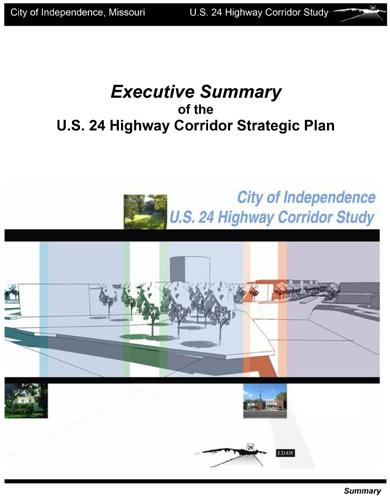


• Transparent – The City of Independence is open and honest with our decisions and supporting data. The matrix process is defendable.

• Visionary – The City of Independence makes smart, long-term decisions that consider future needs. The matrix process considers what is relevant in 2019 and into the future.

DRCC Members CFS Engineers + MCD Associates + B.M. Scott & Associates 15
Image of some of the documents reviewed
Decision Matrix Process
The following is a description of the process:
Task One – Meeting on January 18th to review all of the criteria. Committee members met to add, subtract, and modify criteria to meet their needs. They then completed an exercise to establish which criteria are “best,” “better”, or “good” (since all criteria have been identified to be important).
Task Two – Presenters used the criteria and current land use plans within the comprehensive plan to develop presentations with specific focus on relevant projects for evaluation.


Task Three – The identified relevant projects were prioritized using the Decision Matrix.
Task Four – Cost estimates were created for every project that scores well or is anticipated to be politically supported. This is what the CFSE team calls the Quantitative Analysis. This tasks requires the team to make assumptions for the following costs: cost to design, cost to acquire land, availability of leveraged dollars, cost for maintenance and expected return on investment.
Task Five – DRCC reviewed the decision matrix and expected costs. DRCC will make recommendation to City Council in September of 2018.

CITY OF INDEPENDENCE Downtown Redevelopment Coordinating Committee (DRCC) 16
Englewood Roundabout and Proposed Park
Englewood Promenade
Truman and Winner Projects
The following is a list of the criteria used within the Decision Matrix. Definitions are included within the Appendix.

Part
1
City Strategic Goals Criteria
Increase Economic Prosperity
Stabilize and Revitalize Neighborhoods
Improve Visual Appearance
Improve Public Infrastructure and Facilities
Achieve Livability, Choice, Access, Health and Safety
Through a Quality Built Environment
Feasibility/Viability/Desirability Criteria
Likelihood of project success
Positively affects a large population
The Maturity of the Project
Geographic Continuity
Increased recreation opportunities
Connectivity to regional pedestrian / bicycle routes
Phasing
Part 2
Optimize Resources Criteria
High Opportunity to Leverage Additional Grant or Private Dollars
Low Future Maintenance Cost
High Expected Return on Investment
Low Project Cost to Design and Build
Support Criteria
Community Support
Cohesion of Vision
Political Consideration
DRCC Members CFS Engineers + MCD Associates + B.M. Scott & Associates 17
Example Phase 1 Decision Matrix
Phase 2 - A financial review assessing costs and economic development tools that could be brought to bear to finance the projects.


Developed expected cost to 87 projects and applied hypothetical revenue sources.
Phase 3 - A qualitative/subjective review that applied historic knowledge, community trends, achievability, public responsiveness/perception, economic impact and private sector attractiveness.
DRCC & CFSE Analysis, Synthesis & De-confliction
• Reviewed & scored 16 plans and 400+ separate projects based on City’s Goals and Objectives

• Gained verbal input and Top 5 projects verbatim from DRCC members
• Created spreadsheets with available projected budgets
• Evaluated projects and “clustered” like and contiguous projects or overlapped projects
• Evaluated projects that might be done in conjunction with other projects to allow for maximization, efficiencies and reassignment of funds
• Evaluated and applied hypothetical funding sources to bring outside funds in and to reassign City funds to more priorities or, potentially, for a match or incentivization
CITY OF INDEPENDENCE Downtown Redevelopment Coordinating Committee (DRCC) 18
Tourism Wayfinding Kiosk Projects
Downtown Square Projects
US-24 Roadway Improvements (Fairmount District)
Independence has a proud history and heritage. It has an identity and a central core, but that core needs a little help. In all great stories of communities that have sustainable redevelopment there is a common thread…a strong and vibrant downtown; a central place of gathering; a center of a City’s pride. Here, that place is the Independence Square, where pioneers and immigrants supplied themselves for the trek west; where the Union Army gathered for the great battles for the soul of Missouri; where cowboys and card sharps met in saloons; where the famous and infamous did their deals. And where a great President learned to lead…where he walked and where he died.
There is understandable concern about City-wide support for a Square-centric economic development initiative. However, a Square redevelopment initiative is a next logical step in the overall journey for the redevelopment of Independence. Eastern and Southern Independence have been a focus of both the public and private sector in creating economic development nodes and vast new infrastructure that is creating economic vitality leading to a resurgence in Independence. Those economic engines are showing great promise and gathering momentum. The Square and Western Independence should become a part of the Independence resurgence.

One theme that could be appropriately adopted is “Independence Is On A Roll”. Independence was for a time the largest community in western Missouri born from the rolling wagon wheel and then the rolling paddle wheels, then the rolling train wheels, then the rolling tractor wheels, then the rolling truck and car wheels. Our imagery would be of motion and progress and civic pride. We tie Independence’s past to its present and then its future.

DRCC Members CFS Engineers + MCD Associates + B.M. Scott & Associates 19
MESSAGING STRATEGY AND CONCEPT
Truman and Winner Projects
US-24 Pedestrian Promenade (Fairmount District)
Potential Messaging Characterization
“Independence is on a roll. It’s always been on a roll from Conestoga wagons to those of the western pioneers. From the great steamboats that docked north of the City to the steam locomotive that transported goods and people, gamblers, politicians and dignitaries. From industrial production of tractors and farm implements to the great interstate system, Independence has always been a town in motion. A town as proud and bold as its name. “
The City increased its emphasis on blight remediation and set a goal to demolish a minimum of 20 dilapidated buildings each year. In 2018, the City demolished 1010 Hayward after a nearly 20 year history of crime and nuisance violations at the site. The property is in close proximity to the Truman Depot, National Frontier Trails Museum and Bingham Waggoner Estate, and it’s removal is part of an overall strategy to enhance this area for tourism. The City also demolished the prominent American Inn at I-70 and Noland Road to address frequent police calls for service. The City Council approved tax increment financing for the adjacent Market Place Square to spur redevelopment on this key commercial corridor.

CITY OF INDEPENDENCE Downtown Redevelopment Coordinating Committee (DRCC) 20
The new communications center opened in June 2018 on a previously blighted site near the new Independence Utilities Center. The project provides improved working conditions for police and fire dispatch and meets FEMA standards. The design accommodates additional expansion for possibility to house regional dispatch. No City General Fund dollars were used since the project was funded through the 2004 voter-approved public safety sales tax.

In 2017 the City acquired the former Rockwood Golf Course site. The property had long been a source of concern for the neighborhood since it was vacant for some time and zoned for a variety of uses that may not be compatible with nearby residents. The City entered into a lease agreement with MC Power to develop an 8 megawatt solar energy generation farm to stabilize the neighborhood and support the City’s goal to become the Greenest City in America.
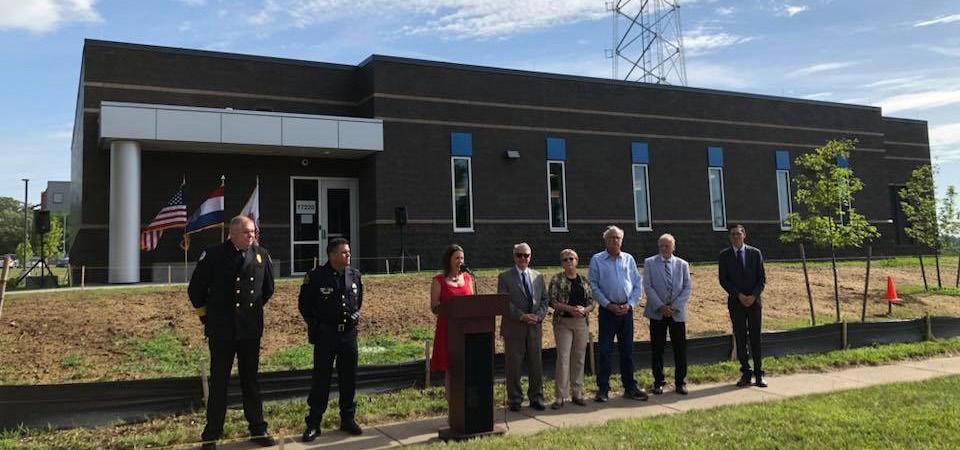
DRCC Members CFS Engineers + MCD Associates + B.M. Scott & Associates 21
The Independence Uptown Market is being designed, funded and constructed in under a year due to tremendous community support and momentum. Over one-third of the $3.3 million project is funded through grants and private donations. The remaining costs are funded by the Parks and Recreation Sales Tax that was approved by voters for recreation amenities. In addition to the farmers market, the facility will house community wellness programs and private rentals.



CITY OF INDEPENDENCE Downtown Redevelopment Coordinating Committee (DRCC) 22
FUNDING / PLAN OF FINANCE
The team identified funding sources that could be applied to the projects as leveraged dollars to enhance the projects and support larger programs include:
• Capital Improvement Plan (CIP) Budget
• Mid America Regional Council (MARC) Funding Programs (STP, TAP, CMAQ)
• Missouri Department of Transportation (MoDOT) Cost Share Program
• Museum / Tourism Sales Tax
• Federal Land Access Program (FLAP)
• Surplus CIP Reinvestment
• 24 Highway Community Improvement District (CID) Sales Tax
• Independence Square/Englewood CID
• Tax Increment Financing (TIF)
• General Obligation (GO) Bond
• Public/Private Investment Partnership (P3)
• Opportunity Zone Utilization
Revenue Source Evaluation Methodology
• Assigned budgeted CIP Dollars to “Above the Line” projects.
• Assigned Targeted MARC and FLAP Grant Projects (80%)
• Assigned MoDOT match funds to qualifying projects (50%)
• Any CIP Dollars that were surpluses from other revenues were reassigned to match share for other projects
• Assigned all remaining project costs to the two planned CID’s (Indep Square/Englewood, 24 Hwy)
• Evaluated projects for potential TIF funding
• Evaluated New Sales Tax (possible Museum / Tourism Tax)
• Potentially fulfill remaining funding needs with G.O. Bond.
Based the Three Phase analysis and information gathered from presentations and written plans there was general consensus in support of project that promoted;
1) Connectivity to economic generation nodes through much of Independence even beyond the Downtown and square area.
2) Multi-modal Transportation connection (Pedestrian, Bicycle, Transit)
3) Complete Streets (Wide-Sidewalks, Lighting, Landscaping, Amenities)
4) Maximization of Independence Heritage, especially the Square
5) New and/or renovated Housing within economic generation nodes to stabilize neighborhoods
6) A new, mixed use Civic Center that is complementary to redevelopment efforts
Of the 16 plans and 400+ projects the DRCC narrowed the list based upon goals established by the DRCC. The DRCC clustered those projects into three broad categories; 1) Independence Square, 2) Downtown Connectivity, 3) Accessibility Enhancement. These categories capture 47 projects reviewed and represent a real and achievable redevelopment plan, that will, nonetheless require significant coordination and cooperation between the City of Independence, the public and businesses both within the target areas and across the City. The aggregate cost of the projects is $204,715,000.
DRCC Members CFS Engineers + MCD Associates + B.M. Scott & Associates 23
POTENTIAL FUNDING SUMMARY

This chart shows a potential funding strategy for about $200,000,000 of projects over the next many years. If one strategy doesn't work, move to the next. This schedule represents many leveraged opportunities with many application periods.

CITY OF INDEPENDENCE Downtown Redevelopment Coordinating Committee (DRCC) 24

DRCC Members CFS Engineers + MCD Associates + B.M. Scott & Associates 25
US-24 Highway Bicycle Facilities
Total Project Cost: $1,320,000

Project Area: Sterling Road to North Spring Street 1.4 Miles
Other Options Include: G.O Bond, MoDOT Cost Share, MARC Funds, CIP

CITY OF INDEPENDENCE Downtown Redevelopment Coordinating Committee (DRCC) 26
Sterling Ave
SAMPLE PROJECT FUNDING
Truman Library
Steamboat Arabia

Total Project Cost: $8,000,000
Steamboat Arabia Size Requirement: 35,000 SF
Steamboat Malta Expansion: 25,000 SF
3rd Boat Expansion 25,000 SF
4th Boat Expansion 25,000 SF Parking Requirements: 100 Stalls
2018 Expected Visitors: 100,000
2021 Expected Visitors: 200,000
2025 Expected Visitors: 200,000

Ticket Price Sales: $15-$20 for Adults
Gift Shop Sales: $120,000+ per year
Other Options Include: G.O Bond, Square CID, CIP
DRCC Members CFS Engineers + MCD Associates + B.M. Scott & Associates 27
Fairmount Promenade
Total Project Cost: $800,000

Project Area: On US-24 from Sterling Road east to North Spring Street

1,500 Feet
Other Options Include: FLAP, MARC Funds, CIP
CITY OF INDEPENDENCE Downtown Redevelopment Coordinating Committee (DRCC) 28
Cycle Track on North Liberty Street
Total Project Cost: $2,057,000
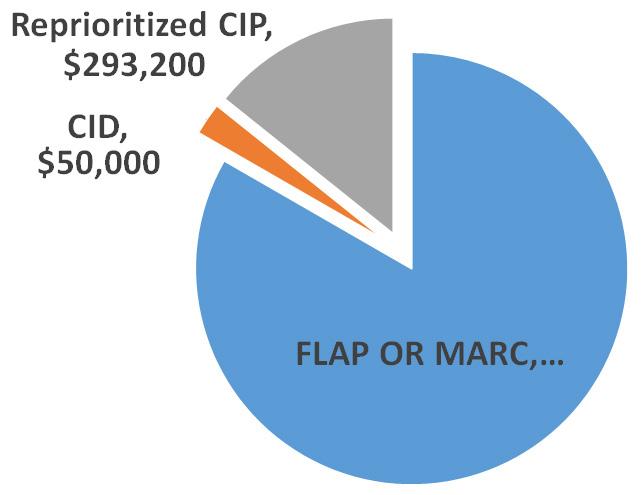
Project Area: On North Liberty from US-24 south to W. Pacific Ave
1 Mile (Follows Metrogreen Regional Trails Route)

DRCC Members CFS Engineers + MCD Associates + B.M. Scott & Associates 29
RECOMMENDED LIST OF PROJECTS
and Initiatives to be Pursued and Implemented
The following list is recommended by the DRCC for pursuit and implementation by the City of Independence. The DRCC believes that this list represents a real, tangible and effective step forward for Independence that will;
1) Spur economic development and job creation;
2) Promote tourism and foot traffic;
3) Remove blight;
4) Enhance the quality of life;
5) Attract private investment.
The list, taken in the aggregate will have a real impact on the trajectory of Independence and builds upon the strengths of Independence; its culture, character and heritage. While this list is largely focused on restoring the core, it will strengthen the heart of Independence, which will have lasting benefits for all current and future citizens. The DRCC believes that a dynamic Plan of Finance that extends Independence dollars through the utilization of state, federal and private funds is not only prudent, but desirable.
Heritage Projects
• National Frontier Trails Museum –Complete projects described in the master plan including new shelter and overlook, new entry lobby, new event space, renovate floors, new exhibit staging, parking, and hardscape/landscape.
• Truman Depot Restoration.
• Steamboat Arabia – Acquisition and Construction.
Square Beautification
• North/South Cycle track on Liberty Street (west side of courthouse)(14 blocks).
• Intersection improvements around the courthouse.
• Trees, Furnishing, Irrigation and Pedestrian Lighting around courthouse.
• Pedestrian enhancements on W. Maple, N. Osage, Liberty, W. Lexington, N. Delaware, and N. Main Streets (25 Blocks).
• Truman Connect Project (connecting Truman Library to Square).
Square Civic Center
• Extend W. Maple Avenue – Providing significantly improved access and development frontage to the Square.
• City Center North – New mixed used facility, parking garage and outdoor civic plaza developed in partnership with a developer to maximize the space for public and private uses outside of traditional business hours.
• City Center South – New Residential Tower with mixed-use on the ground floor and underground parking garage.
• Community Center – Explore a new community center to house major recreation facilities and community gathering spaces.
CITY OF INDEPENDENCE Downtown Redevelopment Coordinating Committee (DRCC) 30
Connectivity towards Englewood
• Truman Connect Project (connecting Englewood to the Square).
• New Gateway at Sterling.
• Promenade with trees and new sidewalks on the south side.
• Traffic calming with pedestrian crosswalks.
Signage/Wayfinding and Downtown Gateways
• Primary and secondary wayfinding signage throughout Independence Square and surrounding areas orienting pedestrians and vehicle to destinations and tourism opportunities.
• Primary gateways at Truman/Noland and Truman/ Main Street intersections.
• Secondary gateways at Truman/Pleasant and Walnut/Spring Street intersections.
Truman Road Projects
• Truman Road streetscape improvements from western limits to Noland Road.
• Intersection and sidewalk improvements at Truman/Winner intersection
• Polly’s Pop Park Enhancements.
• Western gateway improvements on Truman Road.
Fairmount Projects
• Neighborhood Park.
• Pedestrian/Bicycle Promenade and Roadway improvements (parking/landscape island).
• Northside Fairmount Mixed-use Area improvements and parking areas.
• Bicycle connectivity to the Truman Library.
Additional Sidewalk Projects
• Many miles of new sidewalk / curb.
• Sidewalk connectivity around Fairmount Neighborhood (from the NWISHIA Report).
• Fix sidewalk is disrepair along western Truman Road/Mount Washington area.
Additional Bicycle/Walkability Projects
• US-24 Complete Street east of Truman Library.
• Complete Street on Sterling Avenue.
• On-street bicycle connectivity between US-24 and Hill Park.
• Pedestrian Design Enhancements on US24 Bridge Replacement.
DRCC Members CFS Engineers + MCD Associates + B.M. Scott & Associates 31
The DRCC recognizes the importance of revitalizing houses within the historic and heritage neighborhoods of Independence. It also recognizes that a housing initiative is;
1) A complex undertaking for which the Committee is not ideally equipped, and
2) Beyond the scope of the DRCC’s assigned mission.
The DRCC recognizes that a solution or solutions to housing revitalization would be enormously complementary to an overall Independence infrastructure revitalization package and would meet many of the criteria that the DRCC used in evaluating and selecting infrastructure projects for pursuit and implementation. Therefore the DRCC recommends:
1. That the City support efforts to explore a housing revitalization initiative.

2. That the City either actively supports efforts to develop a housing revitalization initiative, potentially, inclusive of a separate ballot initiative.
3. That the City explore providing administrative support to a housing revitalization initiative.
4. That the City entertain any cooperative agreements or intergovernmental cooperative agreements necessary to facilitate a housing revitalization initiative.
5. That the City actively considers support for grants, tax credits, use of Opportunity Zone and Enhanced Enterprise Zone status, Revolving Loan Funds and initiative petitions to advance a housing revitalization initiative.

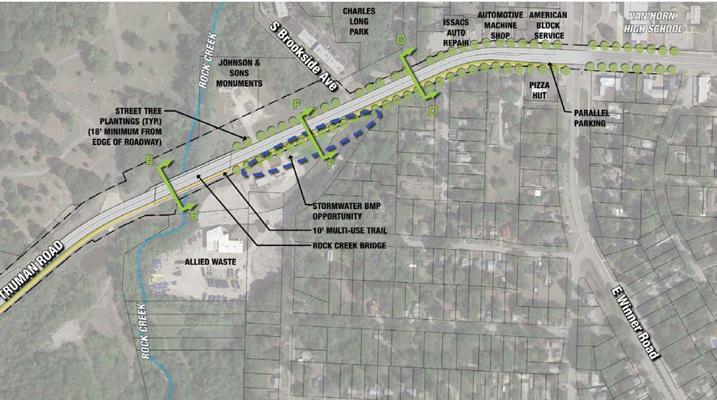
CITY OF INDEPENDENCE Downtown Redevelopment Coordinating Committee (DRCC) 32
HOUSING RECOMMENDATION
Englewood Gateway at Sterling Avenue
Truman Road - West Gateway
Frontier Trails Museum Master Plan
DRAFT IMPLEMENTATION SCHEDULE
The following is a draft schedule for implementation. There is the opportunity for many funding sources to be pursued over the next few years.

DRCC Members CFS Engineers + MCD Associates + B.M. Scott & Associates 33
Example Timeline
Stipulations: Leveling Expectations & Clarification of Goals
• DRCC recommendations are, overwhelmingly, designed to:
o Improve the quality of life for all of Independence
o Maximize the historical and cultural attractiveness of Independence
o Promote attraction to Downtown and Heritage Independence
o Promote economic development and job creation by enhancing connectivity, attractiveness, comfort, efficiency and stay-time
• The DRCC Report and Recommendation is a Citizen Driven initiative. Citizen led and driven initiatives are the best hope for success in Independence.
• It should be acknowledged and commended that neighborhood groups, business organizations and volunteer citizens have advanced and are advancing many of the initiatives listed on the DRCC recommendation list. The City hopes to lead, as needed and follow, as needed with equal enthusiasm.
• It is profoundly NOT the desire of the City to “takeover” initiatives by civic and neighborhood groups, but to help them. It WILL be a priority to have awareness of the plans in hopes that the plans could be influenced to maximize economic impact and perhaps create continuity and connectivity between the individual initiatives and in pursuit of implementing the DRCC recommendations.
• The DRCC recommendations contain approximately $200 million in projects, of which, it is hoped that $100 million will come from state and federal grants and incentive district financing. Approximately $100 million may, necessarily, need to be considered to come from City revenues that may require a ballot issue.
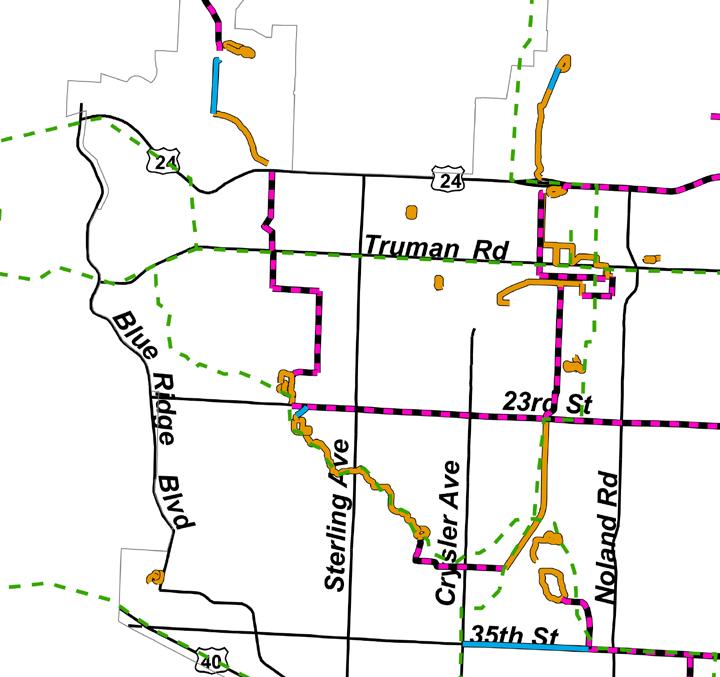

• City revenues should be positioned as “leverage” dollars or the “dollars of last resort”.
• There will be a Master Plan of Finance that contains several smaller, tailored and individualized Plans of Finance. The “Plans” will be dynamic and ever-changing. Their size, sources and uses will be dictated by success, failure, political palatability and opportunity.
• The City will not be driving every Plan of Finance, but should attempt to have visibility of all of them, as well as the Scope of Work (area) to be addressed. The City/Consultants should review the Plans of Finance and Scope of Work
• In return for the City’s support, the individual groups, it is hoped, would join in supporting the larger initiative as represented by the DRCC recommendations.
CITY OF INDEPENDENCE Downtown Redevelopment Coordinating Committee (DRCC) 34
IMPLEMENTATION STRATEGY
Parks Master Plan
Trails Master Plan
Next Steps - DRCC Implementation and Critical Path Recommendations:
The DRCC recommends that the City form an Independence on a Roll Working Group (IRWG) for advancing the initiatives within this Report. This leadership group should accomplish the following:
a. Develop specific plan for advancing projects (short, medium and long-term)
b. Refine the Plan of Finance so specific funding sources are identified and implementation plans are established for each funding source
c. Pursue discussions with Steamboat Arabia group as a potential revitalization showcase project
d. Continue work on identifying most appropriate elements of a new Civic Center, including Public/ Private Partnership options
e. Determine to viability of incorporating the Justice Center into the overall Plan of Finance
f. Secure City Council approval for funding strategies
In the future, the IRWG will be able to transition the DRCC to a Citizens’ Advisory Group for Independence in Motion This group of community leaders will act as a sounding board, advisory group and, potentially, advocacy group for future greater downtown area initiatives.
Initiatives to Be Driven by the Independence on a Roll Working Group (IRWG)
The Independence in Motion Working Group is designed to be a working committee made up of City staff, private citizens and consultants who will be charged by the Chair to pursue and accomplish various tasks by assigning appropriate members, teams or subcommittees to their completion or conclusion.
1. Guiding or Jump-Starting Elements of Overall Pan of Finance (G.O. Bond, Museum/ Tourism Tax, TIF, Grants)
2. Pursuit of Grants Contained in Plan of Finance (POF)
3. Steamboat Arabia/Steamboat TIF Plan
4. Education Institution Tie-in for Civic Center
5. Formation of Square CID and/or Englewood CID(s)
6. Formation 24 Highway CID
7. Formation of Justice Center CID
8. Mixed Use Civic Center Concept
a. New mixed used facility to house city offices and share private facility partner(s) to maximize the space for public and private uses outside of traditional business hours
b. Residential Tower
c. Civic Space
d. Recreation Center/Justice Center
e. Design/Build, CM at Risk
DRCC Members CFS Engineers + MCD Associates + B.M. Scott & Associates 35
9. Revitalization Messaging Package, Branding/Marketing in Concert with Overall City Branding Strategy
Implementation Strategies & City Resources to be Deployed in Support
• Study the Uptown Market initiative and replicate the process as appropriate.
• As represented by the DRCC recommendations, form the Independence on a Roll Working Group (IRWG) to divide and address the initiatives and make the most efficient use of City staff and consultant support.


• Work with the Public Information Office to develop a comprehensive list of; 1) The General Media; 2) Civic and Community organizations with e-mail list or newsletters; 3) Neighborhood Newsletters in the target area; 4) Stakeholders, Opinion Leaders, Civic Leaders, Civic Boosters and Neighborhood list to be entered on a “Stakeholders List” for regular e-mail updates.
• Maintain contact and bolster awareness of advocacy group visions and progress. Provide them situational awareness of the overall goals of the City.
• Evaluate web presence and social platform opportunities in conjunction with the Chamber and other advocacy groups. Create interconnections.
• Consider scorecards and metrics
o State, federal, private funds being sought (leveraged)
o State, federal, private funds secured
o Overall project status list
CONCLUDING REMARKS
The Downtown Redevelopment Coordinating Committee is grateful for the opportunity to help the City set a course for moving forward with improvements listed above. Through this process, the DRCC has gained an in-depth understanding of the needs in the community, especially in the heart of Independence, and how to create a "road map" for implementation. The DRCC recognizes that it may take a decade or longer to accomplish the $200 million of recommended projects, but it can be accomplished with concerted focus and the full utilization of grants, incentive districts, existing City revenues and new revenue streams. The DRCC believes if community organizations in concert with the City properly organize, educate and share the vision and benefits, the community at-large will be supportive.
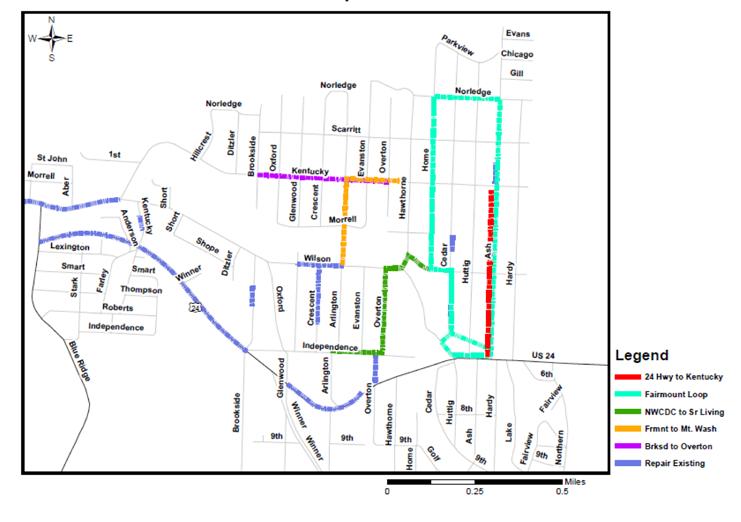
CITY OF INDEPENDENCE Downtown Redevelopment Coordinating Committee (DRCC) 36
Downtown Monument Sign Projects
2015 NW Independence Sidewalk HIA
Frontier Trails Master Plan
APPENDIX - FUNDING SOURCES DESCRIPTION
Understanding that the City has limited sources from which to generate capital for implementation, additional strategies should be utilized to pursue assistance and/or funding. Efforts should also be made to prioritize which public improvements are desired to be implemented initially, and to advocate for their consideration and inclusion in the City’s Capital Improvements Plan (CIP), which prioritizes the construction of future public infrastructure improvements. Leveraging available capital funds as part of a larger overall project effort will likely improve the opportunities for securing additional public funds and provide for quicker redevelopment of the downtown area. The information below describes several sources of funding that may be potentially available for the project.
Federal/State
Most of the federal funding sources are administered through the Missouri Department of Transportation (MoDOT) and the Mid-America Regional Council (MARC). Most, but not all, of these funding programs are oriented toward transportation versus recreation, with an emphasis on alternative transportation systems reducing auto trips and promoting inter-modal connections. Many of the following have yearly or every other year submissions. This section is not meant to be an exhaustive analysis of each program and its applicability to the Project but merely introduce them in order to keep them top of mind as opportunities present themselves to advance project funding.
Surface Transportation Program (STP)
The STP provides states with flexible funds which may be used for a wide variety of projects on any Federal-aid Highways including the NHS, bridges on any public road, and transit facilities. Bicycle and pedestrian improvements are eligible activities under the STP. This covers a wide variety of projects such as non-road facilities, off-road trails, sidewalks, crosswalks, bicycle and pedestrian signals, parking, and other ancillary facilities. The modification of sidewalks to comply with the requirements of the Americans with Disabilities Act is also an eligible activity.
Transportation Enhancements (TE)
This program funds projects that serve a transportation need and can be used to build a variety of pedestrian, bicycle, streetscape and other improvements that enhance the cultural, aesthetic, or environmental value of transportation systems.
Congestion Mitigation Air Quality (CMAQ)
Funds are used to pay for transportation projects, including bicycle and pedestrian improvements that improve air quality.
Safe Routes to School (SR2S)
Grants are used to identify and reduce barriers and hazards to children walking or biking to school. This program includes funding for construction. Investigate opportunities to better connect to the Fairmount Elementary School.
National Highway System (NHS)
This program funds improvements to rural and urban roads that are part of the NHS, including the interstate system. Bicycle and pedestrian facilities within NHS corridors are eligible activities for NHS funds.
Highway Safety Improvement Program
Funds projects designed to achieve significant reduction in traffic fatalities and serious injuries on all public roads and pedestrian/bike pathways.
Federal Transit Administration (FTA )
The FTA funds could be used for various elements of The Fairmount District plan. In addition to traditional transit projects, including intermodal facilities such as bicycle parking at park and ride and transit stations, these funds can be used to secure right-of-way for transit/rail corridors.
Federal Lands Access Program (FLAP)
The FLAP funds could be used for connecting to federal lands including the Truman Library and Truman House. Project funding includes sidewalks, bicycle facilities, wayfinding signage, etc.
DRCC Members CFS Engineers + MCD Associates + B.M. Scott & Associates 37
Missouri Department of Transportation Cost Program
The Cost Share Program provides financial assistance to public and private applicants for state highway and bridge projects satisfying a transportation need. As applied to the US-24 Highway and Truman Road, the MoDOT Cost Share Program allows for 50% participation from the State up to $10 Million. In Recent history this program was suspended but gained partial funding of $10 Million in 2017, $15 Million in 2018 and a $20 Million in 2019.
Road Transfer
A road transfer can provide significant funding for an infrastructure project but it also carries with it significant long term cost. The CFS Team’s prior experience suggests that MoDOT could provide upwards of $1 Million per mile for a project of this size. Before something like this could be considered as a viable strategy a detailed cost benefit analysis would need to be completed to substantiate it. If the City did agree to take transfer of a state route, such as US-24 or Truman Road, it can have a positive impact on the amount of Cost Share the project qualifies for.
Given that most of the Federal and State funding opportunities above are a match program the City would need to secure a local match to access them. Generally this is achieved by pledging one or more local revenue streams to some type of debt, inkind or, in the right circumstances, a pay as you go strategy.
City/County (Local Match) Development Funds
Tax Increment Financing (TIF), Transportation Development Districts (TDD) and Community Improvement Districts (CID) capture tax increment or create additional taxes for the benefit of the project area. These funds are eligible for corridor infrastructure improvements.
Tax Increment Financing
Tax Increment Financing allows for the capture of 100% of incremental local property tax and 50% of incremental local sales tax for 23 years to be spent on the redevelopment of a Blighted Area as defined by Statute.
The City of Independence could consider the use of TIF to accelerate that redevelopment and share a portion of the captured revenues with the specific location and use a portion to advance the Project.
Approval of TIF
TIF begins with the establishment of a TIF Commission by the City consisting of specific members to represent the impacting taxing jurisdiction. A plan with specific statutory requirements is submitted for recommendation by the TIF Commission to the governing body of the City. Next the City takes up the TIF Plan and approves it by Ordinance. A TIF plan is usually implemented by a Redevelopment Agreement.
Advantages:
• All allowable spending matches up
• Local control
• Spurs redevelopment
• A plan can cover a large Redevelopment Area
Challenges:
• Impacts other taxing districts
• Political exposure to City
CITY OF INDEPENDENCE Downtown Redevelopment Coordinating Committee (DRCC) 38
Transportation Development District
A Transportation Development District (TDD) may be created to act as the entity responsible for developing, improving, maintaining, or operating one or more “projects” relative to the transportation needs of the area in which the District is located. A TDD may be created by a request petition filed in the circuit court of any county partially or totally within the proposed district.
The district has the authority to finance the project through special assessments; property tax, sales tax, or toll roads. In addition, they can liquidate any and all of the above methods through debt financing.
Advantages:
• Most allowable spending matches up
• Multiple ways to form (property owners, voters or City)
• Multiple ways to approve sales tax (registered voters or property owners)
• Can be noncontiguous
Challenges:
• Use of fund restricted to transportation only
• Formed by Court
• Tax requires an election
• Political exposure to City
• Tax increase
Community Improvement District
A Community Improvement District (CID) may be either a political subdivision or a not-for-profit corporation. CID’s are organized for the purpose of financing a wide range of public-use facilities and establishing and managing policies and public services relative to the needs of the district.
A CID is a separate legal entity, and is distinct and apart from the municipality that creates the district. A CID is, however, created by ordinance of the governing body of the municipality in which the CID is located and may have other direct organizational or operational ties to the local government, depending upon the charter of the CID.
A CID may finance new facilities or improvements to existing facilities that are for the use of the public. A CID may also provide for maintenance and upkeep of facilities
Advantages:
• Broader use of funds than TDD
• Ease of creation, formed by City
• Locally driven
• Board could be appointed by City
Challenges:
• Tax increase
• Political exposure to City
• Limited to public improvements unless blighted
The Challenge for all 3 of these funding opportunities (CID, TDD and TIF) is creating enough revenue generation to be cost effective and make an impact on the project. For instance for a CID or TDD the most logical funding mechanism is a Sales tax. An initial look at a benefit district directly related to the Fairmont Project would generate about $25,000 a year at a maximum 1% sales tax. This would barely be enough to support the Districts administrative expenses. If the City expanded the scope of the project corridor wide this revenue stream could grow to $885,000 a year.
General Funds
Capital Improvement Project: This project could be added to the next capital improvements program for implementation in about 5 years. This would be considered a pay as you go strategy.
DRCC Members CFS Engineers + MCD Associates + B.M. Scott & Associates 39
City-County Partnerships Kansas City Transit Authority (KCATA)
The Fairmount District corridor and specifically US-24 is part of a larger transit system across city and county lines. One of the primary benefits of this overall design and planning approach for revitalizing The Fairmount District is that it provides flexibility for future transportation connectivity. The KCATA is working on a study for a future MAX line bus route into Independence. This corridor is ideally located for enhanced bus services with large redevelopment potential along the corridor. This plan has been crafted to balance the needs of vehicular traffic today, as well as the anticipated needs of expanded transit service in the future.
Volunteers, Corporate and Civic Resources
Non-profit partners: Kansas City River Trails, Inc. is an excellent example of how civic volunteer groups can promote and develop trails in a city. This non-profit entity has worked collaboratively with various City departments for funding and implementation assistance and has used its private status to acquire matching corporate funds and grants that the City may not have been able to obtain.
Local Foundations
Local foundations aligned with sustainability, greenways, exercise, trails or bicycling may provide a source of private funds.
Individual Sponsorships
Individuals, businesses, or corporations may be interested in sponsoring elements of the project. Naming rights, plaques or other forms of recognition are typically placed on constructed pieces in the corridor. Sponsorship is also a good way to fund corridor elements such as benches, trash receptacles, and interpretive areas.
Debt Financing
Any one of the revenue streams above, once committed, could be pledged to some type of debt instrument to accelerate the project funding. This could take the form of special district revenues, city revenues, or even match dollars from a non-local source that are programed at some point in the future.
City Bond Issue
The City could pursue a project specific bond issue or they could add this project to its upcoming vote for approval from its citizens to implement this streetscape as one of the City priority projects, expected to occur in 2018. This would require a city wide election and entail putting city credit on the line.
Missouri Transportation Finance Corporation (MTFC)
The MTFC provides direct loans at a subsidized interest rate to Transpiration Projects within the State of Missouri. Any one or multiple of the revenue streams above can be pledged to MTFC to support a sizable project fund.
CITY OF INDEPENDENCE Downtown Redevelopment Coordinating Committee (DRCC) 40
Criteria Definitions
The following definitions are provided to assist with criteria description, establish accepted assumptions and provide clarity to the respondents working on the decision matrix helping to set City priorities. These criteria are inclusive of City of Independence Strategic Plan priorities.
Part 1 –Criteria Definitions
City Strategic Goals Criteria – This group of criteria document evaluate 2017-2021 Strategic Goals.
Increase Economic Prosperity (Highest Scoring Criteria) – Does the project expend public monies that fosters the creation of an environment that will attract investment and sustainable development in Independence? Does the project 1) attract and create quality employers/jobs, 2) improves the economic environment of existing enterprises/ attracts retail and commercial businesses, and/or 3) addresses any deficiencies in the mix of housing needed to create a sustainable and high quality community?
Stabilize and Revitalize Neighborhoods (Highest Scoring Criteria) – Does the project invest in initiatives that aid in meeting the requirements of a sustainable and healthy neighborhood. Does the project invest in development and initiatives that lead to greater community engagement and pride, while removing conditions that shelter or promote destructive behavior?
Improve Visual Appearance (Better) – Does the project make investments that improve the visual appeal of the community by enhancements to the built or natural environment or removal of elements that degrade the natural or build environment. Does the project investments lead to the removal, replacement or refurbishment of obsolete or habitable structures and/or lead to the enhancement or development of an economically underutilized area?
Improve Public Infrastructure and Facilities (Good) – Does the project make investments in public infrastructure that has broad public benefit and either directly improves the quality of life or leads to the creation of conditions that can improve quality of life, safety, accessibility, health or other goal attainment?
Achieve Livability, Choice, Access, Health and Safety Through a Quality Built Environment (Good) – Does the project promote enhancement of existing and new retail, commercial and domestic developments that generally leads to a more efficient, safe, aesthetically pleasing and sustainable community through policy or capital investment?
Feasibility/Viability/Desirability Criteria - This group of criteria is more qualitative and evaluates additional project goals/opportunities to enhance the City of Independence?
Likelihood of project success (Highest Scoring Criteria) –What is the likelihood that expenditure of public dollars for a project development will meet the project goals for success.
Positively affects a large population (Highest Scoring Criteria) – Does the project affect a large population with the City of Independence?
The Maturity of the Project (Better) – How well known is the need and the desire for a solution and how well-developed the plan for the solution is?
Geographic Continuity (Better) – Does inclusion of a project support a greater corridor connectivity by virtue of its geographic proximity?
Increased recreation opportunities (Better) – Does the project promote sustainable living by increasing recreational opportunities?
Connectivity to regional pedestrian / bicycle routes (Good) – Does the project promote connectivity through increased alternative transportation routes?
Phasing – Ability to implement over time (Good) –Can the project be implement over time?
Part 2 –Criteria Definitions
Optimize Resources Criteria- This group of criteria evaluate amount of public money to complete public infrastructure needs. The team will need to make assumptions for various cost considerations. Does the project manage resources wisely?
DRCC Members CFS Engineers + MCD Associates + B.M. Scott & Associates 41 APPENDIX - DECISION MATRIX
CRITERIA
High Opportunity to Leverage Additional Grant or Private Dollars (Highest Scoring Criteria) - Does a project leverage other public dollars? Are alternative revenues sources available to supplement traditional or innovative financing?
Low Future Maintenance Cost (Highest Scoring Criteria) – Does the project have low operations and maintenance cost?
High Expected Return on Investment (Better) – Does the project encourage private investment to develop around the project?
Low Project Cost to Design and Build (Good) – Does the project have a low design, land acquisition, permitting, and construction cost?



Support Criteria – This last criteria is more subjective, evaluating expected support for a project.
Community Support (Highest/Best) – Either widespread, key or energized support of an initiative or lack thereof
Cohesion of Vision (Higher/Better) – Does a lesser supported project nonetheless match the vision of the overall project thereby arguing for inclusion.
Political Consideration (Good) – Does inclusion or exclusion of a project enhance or reduce the achievability of the overall project
CITY OF INDEPENDENCE Downtown Redevelopment Coordinating Committee (DRCC) 42
Frontier Trails Museum Master Plan
Frontier Trails Museum Master Plan
Tourism Signage Master Plan
Independence Downtown Redevelopment Coordinating Committee Meeting Summary
October 27, 2017
City Hall – 3rd Floor – Conference Room A (111 E Maple St. Independence, MO 64050)
Committee Members Present: Linda Brosam Chair Dougherty, Linda Brosam, Bryan Conley, Tom Garland, Jill Getman, Jennifer Manuleleua, Matthew Medley, Monte Short, Linda Ellis Sims, Trevor Tilton and Alan Williams.
Committee Members Absent: Brian Schultz
Other: Andy Pitts (TreanorHL)
Chair Dougherty convened the meeting at 11:00 a.m. Curt Dougherty welcomed and thanked the committee for volunteering.
Assistant City Manager Lauren Palmer gave an overview of the committee’s scope of work, goals and objectives for the meeting.
Andy Pitts from TreanorHL provided context on the City Hall Master Plan project and asked committee members to consider the following:
When you think of “Downtown Independence” you think of…?
Committee responses:
• History
• A lot of potential
• Needs polishing
• Wish it was more kid-friendly
• Ophelia’s, Café Verona – great places, but don’t cater to young people
• Patio at Courthouse Exchange – live entertainment
• Good libraries
• Downtown is a nice area, just needs a facelift –sidewalks, seating, more trees, community involvement
• Ennovation Center is great, but too far away from the Square
o Lots of crafters in the area; could be a resource
Where do you ___?
1. Go out to dinner
2. Shop
3. Relax
4. Recreation Committee responses:
• Uber to downtown Lee’s Summit
• Oak Park Mall
• Crown Center – always has activity
• Loose Park – nice walking park; peaceful; safe; beautiful trees
• Zona Rosa (indoor playground equipment for kids)
• Downtown KCMO – entertainment & dining
o We have KCMO beat on parking and safety
• Many people do grocery shopping in KCMO because it is culturally relevant
• Square = “eat it and beat it” - dining is nice, but no entertainment to keep patrons on the Square
• Shopping on 39th St., Independence Center – fear about the future of retail, impact of online shopping
• Retail will be dead in 10 years; Square has to sell services and experiences
• Branson
• Eureka Springs
• Worlds of Fun/Oceans of Fun
What would you like to see in Downtown Independence?
Committee responses:
• Kid friendly
• Need apartments/lofts with amenities (i.e. gym); shops will follow people
o Has to be affordable living for downtown
• We’re on the cusp – need to get young people to think of the Square for a weekend night
• More family activities
• Could Square have a location for secure package pick up (retail evolution)?
• Similar to what Lee’s Summit has done
• Brew pub – something that attracts young professionals
• Bring in speakers (model after Unity Temple on the Plaza)
• Bring technology (Pokeman craze)
• More diversity of restaurants/shops
• More high density, mixed use development – commercial w/ residential
DRCC Members CFS Engineers + MCD Associates + B.M. Scott & Associates 43 APPENDIX - DRCC MEETING MINUTES
• More outdoor programming – more outdoor space
o Affordable summer programming for kids
• Indoor space for seating/playground equipment for kids
• Can’t rely on festivals – need more community events
• Redevelopment for bank building on southwest side of Square
• Accessibility and walkability
• Parking is adequate but may get pinched as we grow; need to think about structures
o Need designated parking for employees; leave street parking open for customers
• Biggest challenge is marketing – Independence has a bad reputation; it’s a big misconception
o Need a unified marketing strategy between city and private businesses
• Pet friendly
o outdoor seating that allows animals
o more/better dog parks
Following the discussion, a break was held for lunch and for committee members to complete the Visual Context Exercise. Committee members were asked to select preferred images (green dots) and rejected images (red dots) of various interiors and exteriors of comparable civic buildings and spaces. The desired attributes were as follows:
Exterior
• Not too modern
o Can have modern flair if sensitive to context
• Needs to fit historic character
• Mixed uses – retail, residential
• Needs to be inviting, accessible
Interior
• Bright, natural light
• Vibrant
• Multi-use
• Right-sized
• Warm
• Active spaces
• Year-round use
• Inviting
• Multi-generational
• Timeless; not outdated
Exterior Area
• Trees
• Active family space, but not congested
• Bike path – different color
• Rental bike stations
Key takeaways
• Live, play, work all in one area
• More mixed use – more residential
• Need to keep shops open and activities later
• More greenspace
• Need to attract younger demographic; must have nightlife after 9:00 p.m. Can be upscale.
• Rehab existing buildings (Bank of America building)
• Need to put together an incentive package to draw in the right developer
o Consider incentives (353 tax abatement) for property owners to make improvements
• Constant programming and activities – indoor and outdoor
• City Hall should stay downtown (heart of the City), but it needs to have a mixed use after 5pm. Most city services can be accessed online, but a civic space (not just an office building) could accommodate diverse programming – arts, culture, recreation.
• Space needs to be flexible to work for now yet evolve in the future.
City staff will work on arranging field trips for the next meeting(s) in late November and early December to explore recent developments in peer cities. There being no further business, the meeting was adjourned at 1:34 p.m. An optional tour of City Hall was offered following the meeting.
CITY OF INDEPENDENCE Downtown Redevelopment Coordinating Committee (DRCC) 44
Independence Downtown Redevelopment Coordinating Committee Meeting Summary
January 18, 2018
City Hall – 3rd Floor – Conference Room A (111 E Maple St. Independence, MO 64050)
Committee Members Present: Linda Brosam (arrived 4:20pm), Bryan Conley, Tom Garland, Jill Getman (left at 4:35 pm), Jennifer Manuleleua, Matt Medley, Brian Schultz, Monte Short, Linda Ellis Sims (arrived 4:59 pm) and Alan Williams.
Committee Members Absent: Chair Curt Dougherty, Trevor Tilton
Other: Craig Davis (MCD), Lauren Palmer (city staff), Jim Schussler (CFSE), Sabin Yanez (CFSE)
Palmer explained that Chair Dougherty would be absent and kicked off the meeting at 4:04 p.m. with a round of introductions.
Yanez explained the background of CFS Engineers team that was engaged by the City to assist the committee with its work. He explained the goal of the meeting was to find a methodology to prioritize components of the previously adopted plans to determine a practical path forward. He reviewed the project values, group roles and process description.
The CFS Team facilitated a process to review and prioritize the Prioritization Criteria. The committee completed written ballots to group the City Strategic Goals Criteria. The results were as follows:
Highest- Increase economic prosperity
Highest – Stabilize and revitalize neighborhoods
High – Improve visual appearance
Good – Improve public infrastructure and facilities
Good – Achieve livability, choice, access, health and safety through a quality built environment
The committee completed a second set of written ballots to group the Feasibility/Viability/Desirability Criteria. The results following discussion were as follows:
Highest
–
Likelihood of project success
Highest – Positively affects a large population
High – The maturity of the project
High – Geographic continuity
High – Increased recreation opportunities
Good – Connectivity to regional pedestrian/bicycle route
Good - Phasing – Ability to implement over time
Garland stated that the grouping exercise was a challenge because some of the criteria link together. Short reminded the group that restrictions with certain federal and state funding sources may limit flexibility on some projects. Schultz agreed that economic prosperity is number one because it feeds into so many other aspects of the Strategic Plan. Without intervention there are neighborhoods that will never recover due to housing stock and need for economic opportunity. Williams echoed that all of the criteria support each other. He stated it was most important to start somewhere and build upon early successes.
There was debate about combining Phasing/Maturity into a single criterion. There was discussion about the weighting of “positively affects a large population.” The consensus was that projects along high traffic corridors or that resonate with residents outside of the core area should receive priority.
There was discussion about combining “geographic continuity” and “connectivity to regional/pedestrian bicycle route.” Brosam noted the success in Kansas City of adding new bicycle and pedestrian amenities like bike racks. The decision was to leave the criteria separate to pull out the nuances between the two. Geographic continuity was increased in ranking. Sims highlighted opportunities to link neighborhoods through streetscape improvements.
DRCC Members CFS Engineers + MCD Associates + B.M. Scott & Associates 45
CFS introduced the Part 2 Criteria Definitions and the committee completed another grouping exercise. The results after discussion were as follows:
Optimize Resources Criteria
Highest – Low future maintenance cost
High – High opportunity to leverage additional grant or private dollars
High – High expected return on investment
Good - Low project cost to design and build
Initially “high expected return on investment” was weighted lower. There was discussion about how this category was interpreted by the committee members. The consensus was that the committee wants to prioritize projects that attract businesses and other private investment. “Low Future Maintenance Cost” doesn’t necessarily mean a small project (i.e low hanging fruit projects). Medley highlighted the creative partnership between Gladstone and North Kansas City Schools to operate and maintain the community center. Short mentioned a similar partnership with the YMCA in North Kansas City. Priority would be given to transformative projects that find creative ways to control long-term costs.
Garland mentioned that a low cost to the city may have high impacts on others (i.e. sidewalks maintained by adjacent neighbors). It’s important to design for aesthetics and long-term maintenance. There are examples of significant city investment (Maywood, Fairmount) that were not embraced or maintained by adjacent property owners. Williams interpreted the category to encourage smart upfront investments that may cost more initially but make sense in the long term (i.e. quality building materials).
Support Criteria
Highest – Community Support
High – Cohesion of Vision
Good – Political Consideration
Brosam spoke about the vibrant history of the Independence Square and the importance of having the community fully behind the vision. “Community Support” by far exceeded the other criteria. There was discussion about the relevance of “Political Consideration.” There may be projects that don’t have as much wide appeal but will receive priority due to political support (i.e. high voter turnout, important constituency impact, etc.).
Yanez discussed the next steps. Presentations at upcoming meetings will focus on the Part 1 Prioritization Matrix. Part 2 scoring will happen as a secondary phase once the initial priorities start to rise to the surface.
Palmer reviewed the future meeting schedule and confirmed meeting dates on February 1, 15 and 22. The meeting was adjourned at 5:45 pm.
CITY OF INDEPENDENCE Downtown Redevelopment Coordinating Committee (DRCC) 46
Independence Downtown Redevelopment Coordinating Committee
Meeting Summary
February 1, 2018
City Hall – 1st Floor – Conference Room D (111 E Maple St. Independence, MO 64050)
Committee Members Present: Chair Curt Dougherty, Linda Brosam, Bryan Conley, Jill Getman, Jennifer Manuleleua, Matt Medley, Brian Schultz, Linda Ellis Sims and Trevor Tilton
Committee Members Absent: Tom Garland, Monte Short, Alan Williams.
Others: Craig Davis (MCD), Lauren Palmer (city staff), Tom Scannell (city staff), Tenia Strother (city staff), Jim Schuessler (CFSE), Sabin Yanez (CFSE)
Chair Dougherty convened the meeting at 4:07 p.m. Schussler gave an update on process. Community Development Director Tom Scannell presented the Imagine Independence 2040 update to the Comprehensive Plan as summarized in the attached powerpoint presentation and land use map.
He also presented the 24 Highway Corridor Study as adopted in 2006. Of the 28 short-term recommendations in the plan, few have been implemented, either in whole or part. The 353 Tax Abatement program in northwest Independence had limited effect since the abatements were not concentrated in a small enough area to make a noticeable impact. The program closed in March 2017. There were different opinions from the committee about the ease of the application process for owners.
The 25-year abatement may have been too long as often the City is dealing with a third or fourth property owner. The properties tend to fall back into disrepair before the abatement has expired. Independence School District achievements have had a positive impact on growth as evidenced by a second new elementary school.
Several recommendations in the 24 Highway Corridor Study dealt with traffic circulation and business development in the Fairmount Business District, which prompted the City to complete the 2018 24 Highway Fairmount Business District Plan. Schussler presented the eight key recommendations from the plan (flooding improvements are not included):
(1) Promenade design – pedestrian spaces on both sides of the road
(2) Neighborhood park - to replace Hink greenspace and serve as a community gathering place
(3) Roadway improvements – medians, curbs, sidewalks
(4) Multi-modal connectivity to Truman Library
(5) Crisp Lake improvements – inactive ownership since 1928
(6) Crisp Lake Trail Connection toward Truman Rd. (Committee members expressed concerns about completing (6) independent from (5).
(7) Removal of Huttig Lighted Intersection
(8) Roundabout on 24 Highway – The project could be iconic by calming traffic, incorporating public art and spurring redevelopment opportunities. There were mixed reviews from the stakeholders during the planning process
Palmer reviewed the future meeting schedule and confirmed meeting dates on February 15 and 22. The meeting was adjourned at 5:57 pm.
DRCC Members CFS Engineers + MCD Associates + B.M. Scott & Associates 47
Independence Downtown Redevelopment Coordinating Committee Meeting Summary
February 15, 2018
City Hall – 1st Floor – Conference Room D (111 E Maple St. Independence, MO 64050)
Committee Members Present: Linda Brosam, Bryan Conley, Tom Garland, Jill Getman, Jennifer Manuleleua, Matt Medley, Brian Schultz, Linda Ellis Sims, Monte Short and Trevor Tilton
Committee Members Absent: Chair Curt Dougherty, Linda Ellis Sims, Alan Williams
Others: Craig Davis (MCD), Lauren Palmer (city staff), Tom Scannell (city staff), Jim Schuessler (CFSE), Brad Scott (CFSE Team), Tenia Strother (city staff), approximately 18 community guests
Palmer kicked off the meeting at 4:03 p.m. with a round of committee introductions. Schussler and Scott gave an overview of the process and meeting agenda.
Independence Square Association
Jeff Rogers, Executive Director of the Independence Square Association (ISA) presented the Square Streetscape Plan. He explained that the Link Independence Plan and Square Revitalization Plan would be covered in more limited detail. The Link Independence Plan was more of a “dream” that was completed by college students, but it has some themes with other plans. The following were the key priorities presented by ISA:
• More gateway elements at entrance points to highlight the destination.
• Desire for more greenspace or planters; sources of irrigation will be needed to maintain vegetation.
• Return of two-way streets on the Square for overall flow and traffic circulation.
• Information kiosks and wayfinding signage; it is difficult to find the Visitors Center within the Courthouse, and the Center is not always accessible during peak visitor times.
• Widening of the sidewalks to accommodate outdoor dining.
• Re-evaluate maintenance of the sidewalks. Currently the responsibility falls to adjacent property owner which is a burden for businesses and creates inconsistency on the streetscape.
• Add or repair sidewalks throughout the Square and add a multi-modal cycle path on Liberty to link to other neighborhoods. Use decorative brick/concrete for crosswalks.
• Replace trees in streetscape.
• Overlay district for signage and other design elements.
• Streetlights that hold hanging planters.
• Planned placement of trash cans.
• Recycling cans (Greenest City element)
• Benches
• Trail connections from Depot to National Frontier Trails Museum to Square to Truman Library. Make the visible, walkable connection between spaces.
• Trail connections to Englewood Station Arts District and Maywood/Truman Rd. Corridor –wayfinding signage, entryway to the city center.
ISA is working to become a Missouri Main Street community. It is early in the process, but there may be opportunities to build consensus for economic incentive tools to fund improvements. There was discussion about parking on the Square. Rogers stated that there is not an immediate need, although perception may be an issue. Parking will become more taxed as residential units develop near the Square.
Englewood Station Arts District
Monte Short presented the Circulation Plan for the Englewood Station Arts District. The plan is very feasible compared to other studies completed over the years. Maintenance is an ongoing challenge, so the district wants to have a funding mechanism to maintain any improvements. There have been problems in the past with trying to rely on property owners to maintain plantings. Desired Project Improvements:
• Roundabout at Northern and Winner
• Parking – improve the parking lot behind Englewood Theatre (doubles parking)
• Add medians/planters with vegetation between parking on Winner Road; traffic calming and attractive
CITY OF INDEPENDENCE Downtown Redevelopment Coordinating Committee (DRCC) 48
• Lines are in for sprinkler system on the north side, but irrigation is not operational.
• Restore the historic trolley car as the western gateway monument.
• Restore historic Glenwood Theatre sign at Sterling & Winner.
• Find a way to reopen the Englewood Theatre; rehabilitate the Ben Franklin and Comprehensive Mental Health properties.
• Allow accessory dwelling units (ADU) to increase density.
Other:
• Cost of beautification and streetscape improvements is $3.3 million and can be phased out.
• US 24 Corridor Study action plan steps are relevant for Englewood, Maywood, others. Housing is the top priority that neighborhoods can address to help themselves.
• Statistics demonstrate decline. 15% of housing is vacant in Englewood. Average household income is less than $44,000.
• There is a group working to develop a Sales Tax CID. There is also interest in an Arts Overlay District to attract residential. Need to further explore an idea to layer a 353 tax abatement program with a CID for improvements or incentive programs (revolving loan fund for commercial and residential improvements).
Tammy Parsons (Englewood Business Owner) commented on the importance of preserving the community and making connections to the other neighborhoods in the first district.
Maywood/Truman Corridor
Community Development Director presented on the adopted plans for the Maywood/Truman Corridor.
Truman Road Green Gateway – The plan wanted to capitalize on the gateway’s potential for the corridor to take full advantage of the I-435 interchange. It recommended a land use plan with density and commercial development focusing on nodes at I-435, Blue Ridge Blvd., & Winner Rd. The plan included a commercial redevelopment vision for Winner Road and 10-ft wide multi-use path along Truman Rd. Corridor improvements were estimated over $4 million for portion in the city limits.
Truman & Winner Road Commercial Node
Plan – Intended to address traffic concerns associated with Van Horn High School. Recommendations include: (1) remove landscaped medians on Winner Road and creating a bus turnoff (fence on Truman Road to protect pedestrians); (2) install 10’ sidewalk on east side of Winner Road; and (3) enhanced the intersection with crosswalks, signage, etc. Improvements were estimated at $1.8 million. The City is applying for a Surface Transportation Program (STP) grant in 2018. A concern was raised about a lack of a safe pedestrian crossing at Winner Road across Hwy 24. Students are currently using the railroad tracks.
Mid-Town/Truman Road 353 Development Plan – 353 is a section of the state statutes that refers to tax abatement. The goal of the program was to try to preserve single-family homes and slow conversion to multiple rental units. It was considered more successful than Fairmount / Carlisle because it was concentrated in 72 square blocks. As of January 2018, approximately 750 properties participated. There are 320 currently in the program. Funding was allocated (approximately $35,000) for enhancements to Polly Pop Park.
Palmer reminder the committee of the final presentation meeting on February 22 at 4:00 p.m. in Conference Room A. The meeting was adjourned at 5:57 pm.
DRCC Members CFS Engineers + MCD Associates + B.M. Scott & Associates 49
Lindsay Browne spoke on behalf of the Truman Gateway Corridor.
Independence Downtown Redevelopment Coordinating Committee Meeting Summary
February 22, 2018
City Hall – 3rd Floor – Conference Room A (111 E Maple St. Independence, MO 64050)
Committee Members Present: Chair Curt Dougherty, Bryan Conley, Tom Garland, Jill Getman, Jennifer Manuleleua, Matt Medley, Brian Schultz, Linda Ellis Sims, Monte Short and Trevor Tilton
Committee Members Absent: Linda Brosam, Alan Williams Others: Mayor Eileen Weir, Tim Gramling (city staff), Morris Heide (city staff), Alicia Nelson (city staff), Lauren Palmer (city staff), Tenia Strother (city staff), Eric Urfer (city staff), Zach Walker (city staff), Jim Schuessler (CFSE), Sabin Yanez (CFSE), Ryan Jacobs (TreanorHL), Andrew Pitts (TreanorHL), 3 community guests
Dougherty kicked off the meeting at 4:01 p.m. with a round of committee introductions. Sabin gave an update on the process and announced the next meeting on April 5.
Harry S. Truman Presidential Library Master Plan (2017)
Dr. Kurt Graham of the Presidential Library explained plans for expanding parking and exhibits to improve the flow of the visitor experience. The Library appreciates support from the City to work with the Missouri Department of Transportation to secure a commitment to replace the Hwy 24 bridge over Bess Truman Pkwy. Additional community resources will be necessary for decorative enhancements that exceed the basic MoDOT standard. The Library plans to implement its improvements and reopen by April 12, 2020 – 75th anniversary of Truman’s presidency. They are currently working on the capital campaign and with consultants to work through federal process. The goal is to continue to work with the City to improve and beautify the Hwy 24 corridor as a gateway to the library. Committee members asked for additional information the amphitheater. The concept is not part of immediate plans due to funding, but eventually it could be a civic space to support outdoor programming. Graham also clarified that the glass vestibule has been scaled back from original concept.
Northwest Independence Sidewalk Health Impact Assessment (2014)
Assistant Health Director Alicia Nelson explained that residents in zip code 65043 were most dissatisfied, felt most unsafe, and had highest obesity levels in the annual health impact assessment. The sidewalk assessment was an effort to respond to concerns in that area. She provided a map of the six recommended options in the plan. The Fairmount loop was the highest priority on the list. Funding was allocated only for the community engagement to determine priorities, but none of the identified priorities were estimated or funded.
Parks/Recreation/Tourism (PRT) Plans
Parks/Recreation/Tourism Director Eric Urfer summarized the five departmental plans that have relevant projects for downtown. Extensive community involvement resulted in priorities in community recreation plan: (1) broad-based community programs; (2) populate PRT facilities and sites; and (3) support larger community events. The primary objective in the Parks Plan is to maintain existing parks and facilities. The master plan calls for a new sprayground somewhere near the Square and another in the Fairmount neighborhood. Unfunded needs include a special event park and a new recreation center (similar to Lenexa or Gladstone). The right location for a large recreation center (50K+ sq. ft.) has not been determined.
Relevant projects from the Trails Plan include:
• Truman Connector Trail
• Rock Creek Trail
• NPS Retracement Trail
• 70/470 to Square via Truman Rd. Connection
A grant was awarded last year to enhance the Truman Depot and to convert it to a Whistle Stop café. The City is coordinating with the Truman Library to make this another visitor destination.
The Historic Sites Plan establishes a routine maintenance program. The City is completing a grants-funded needs assessment to determine and fund all future needs. Urfer provided an overview of the updated Tourism Marketing Plan. He answered questions from the committee about specific historic projects including improvements to the National
CITY OF INDEPENDENCE Downtown Redevelopment Coordinating Committee (DRCC) 50
Frontier Trails Museum, Water Tower, and Steamboat Arabia Museum. Some of the cost estimates will be validated by the assessment. He also provided additional information about park improvements at Polly’s Pop Park, Bingham Waggoner Estate, McCoy Park, Hiram Young and Young Park.
City Hall Master Plan
Andy Pitts from TreanorHL did a recap of the work done so far on the public facilities analysis for downtown. The major priorities identified were: (1) enhance City Hall but also the downtown environment; (2) expand downtown activity beyond 8-5; (3) attract residents. Concepts were reviewed to renovate the existing City Hall in a phased construction to maintain operations. Other options were considered that may better meet the priorities identified. A new City Hall could mirror the Lenexa model of incorporating other uses into civic spaces. One potential idea was a tourism center coupled with the National Parks Service. Truman Road would be the vehicular corridor with pedestrian connection directed toward the Square. The goal is to create a vibrant, active space. City Hall could be a catalyst to attract a mixed-use development (with shared parking) with dense residential to support downtown retail and services. If the Police Department moved out to another site, the new recreation center could be located adjacent to Noland Road to further support activity.
Schultz asked Pitts to review the original needs analysis related to the current City Hall. Importance of civic space to just “hang out” gives visitors a reason to come and enjoy shopping/dining and stay. Dougherty stated that the new Farmers Market is an experiment to gauge the public’s excitement for the visual impact. Will there be community support to move forward to the next level to enhance the Square? If the support is there, we need to be ready to move on a big vision. Tilton – remodeling this building is throwing good money after bad. If we are going to do one thing, there has to be a vision to do it all. It’s a shame not to do it with the momentum that is building.
Yanez explained that the consultant team will now start to digest the plans and the feedback from the committee to draft a scoring summary for further review by the committee.
The meeting was adjourned at 5:57 pm.
Independence Downtown Redevelopment Coordinating Committee Meeting Summary
April 5, 2018
City Hall – 3rd Floor – Conference Room A (111 E Maple St. Independence, MO 64050)
Committee Members Present: Chair Curt Dougherty, Linda Brosam, Bryan Conley, Jill Getman, Jennifer Manuleleua, Matt Medley, Brian Schultz, Monte Short, Trevor Tilton and Alan Williams.
Committee Members Absent: Tom Garland and Linda Ellis Sims
Others: Mayor Eileen Weir, District 1 Council Member John Perkins, Lauren Palmer (city staff), Tenia Strother (city staff), Zach Walker (city staff), Jim Schussler (CFSE), Sabin Yanez (CFSE), Brad Scott (CFSE team), Craig Davis (CFSE team)
Yanez kicked off the meeting at 4:03 p.m. and explained the preliminary scoring of all projects identified from the downtown plans. The team worked to develop cost estimates for projects that did not have them or update estimates stated in plans.
Brian Scott and Jim Schussler elaborated that the meeting would have little by way of presentation and instead would be an opportunity for committee dialogue on priorities. The next meeting will cover potential financing options. Schussler reviewed the two DRCC focus area maps:
1. All 89 projects
2. Projects identified as “above the line” in the initial scoring
Scott explained Five Key Takeaways from Prior Discussions:
1. Independence is proud of its history and heritage and wants to preserve and promote it.
2. The Square and downtown are points of pride, and the City seeks to maximize economic potential of those areas.
3. The City seeks to connect historic areas and business districts.
4. The City seeks to make public investments that attract private investment.
5. Investments should promote tourism, attract visitors for extended stays and drive repeat traffic.
DRCC Members CFS Engineers + MCD Associates + B.M. Scott & Associates 51
Reactions from the Committee:
• There is a misconception that community investment is wasting money. These improvements are supported by the committee and educated/ engaged citizens, but maybe not widely understood or supported.
• Acknowledging that history is important, we also have many newcomers who do not connect to the history. Our community identity needs to consider our changing demographics and the future.
• Some were surprised to see the National Frontier Trails Museum ranked so high. There was discussion about the different potential for impact from a renovation versus a full restoration overhaul. People visit for trails, Truman and the church. There needs to be a vision of how an improved museum could connect to the broader tourism strategy and history.
• Although there is debate about the exact route, the plan includes priorities for the connection from the Truman Library to the Square to the Truman Depot. Bike trails and connectivity should include religious sites of the Community of Christ Church.
• There is excitement about the potential relocation of the Steamboat Arabia museum. It would be a major “coup” for Independence to generate excitement and anchor the neighborhood.
• People are interested in basic improvements –unfunded sidewalks and curbs.
• It’s easier to support a new City Hall if we demonstrate success with other projects first.
• The vision is more than a new City Hall and rather a civic center that attracts activity outside the hours of 8am – 5pm. The concept of a Tourism/Visitor Center is exciting. Could there be other partnerships – higher education? Culinary college? Other uses?
• Sermon Center has limitations with space and deferred maintenance. There is no excitement about spending money on that facility with no expansion in amenities or uses. But people like historic preservation. Could there be another reuse for the space?
• Request to move the Fairmount North Side mixed use area just above the line – need to have a finished project to demonstrate something big instead of a small connector.
• There is strong support for complete streets.
• The last 3 sidewalk projects (NWISHIA 3-5) are not as important as other needs and can fall below the line.
• The Gateway at Sterling needs to be above the line for Englewood – at least in part; could it be incorporated with the Sterling complete street project?
• It is really important to figure out how to get private sector involvement – otherwise it is just dumping endless public money with no growth in the economy or long-term sustainability.
The committee discussed a homework assignment of ranking top 5 priorities via email. Staff would schedule the next meeting in May to cover financing. The meeting adjourned at 5:45 p.m.
CITY OF INDEPENDENCE Downtown Redevelopment Coordinating Committee (DRCC) 52
Independence Downtown Redevelopment Coordinating Committee Meeting Summary
May 15, 2018
City Hall – 3rd Floor – Conference Room A (111 E Maple St. Independence, MO 64050)
Committee Members Present: Bryan Conley, Tom Garland, Jennifer Manuelelua, Matt Medley, Brian Schultz, Monte Short, Linda Ellis Sims and Alan Williams.
Committee Members Absent: Linda Brosam, Chair Curt Dougherty, Trevor Tilton
Other: Craig Davis (MCD), Lauren Palmer (staff), Brad Scott (CFSE team), Jim Schuessler (CFSE), Sabin Yanez (CFSE), Mayor Eileen Weir
The meeting was called to order at 4:09
Yanez welcomed the committee and explained that the meeting would be a financing workshop to start to determine how priority projects can be implemented. He presented the attached powerpoint with input from fellow CFSE team members. Five hypothetical projects were reviewed to demonstrate potential sources and uses for implementation.
There was discussion about how much could be generated through a community improvement district (CID) around the Square. CFSE recommended a larger boundary (for example, Englewood and the Square) to take advantage of economies of scale. Precautions could be established in the bylaws or through operating agreements to appropriately allocate operating dollars. Davis explained the revenue source evaluation methodology. All of the “above the line” priorities amount to $200 million and the process yielded approximately $200 million in projected revenues.
The committee discussed the following items for further evaluation:
• Need to re-evaluate 15.07 Complete Street project on Delaware Ave. Was that street recently redone?
• Confirm all revenue estimates.
• Figure out what is attainable and develop a concrete
plan. Avoid spending money on design and only implement a handful of projects.
• Determine the right kind of study for the community center. Need to verify operating costs to understand long-term cost implications.
• Need to identify signature project(s) to sell the vision to the community. City Hall is not compelling.
• Ask Springfield, Columbia, Lenexa, Lee’s Summit, Gladstone, etc. – Total investment in downtowns in last 10 years
$200 million is doable for a community our size. Other communities have done projects this ambitious. Is Independence ready for a project of this magnitude? Is it progressive? Twelve years ago the vote on the school annexation was ugly but community-driven. It was significant. It has been transformative. The potential is there. It starts with how we craft the message and approach people. The message needs to appeal to the entire community because of gateways, access and relevance of the Square. We need door-to-door table top conversations (not focus groups). We need to focus on an education program, not a campaign.
There was discussion about the important need to bring up problem residential properties, particularly in western Independence. Palmer stated that housing challenges may be outside of the scope for the DRCC. Housing is a priority in the Independence for All strategic plan, and it is being worked through other channels.
There was concern that the priority projects do not focus enough on downtown i.e. streetscapes, vacant buildings/ storefront, more/diverse residential near the Square, street lighting, density, bikes, trees, walking dogs, etc.
The meeting adjourned at 5:53 p.m.
DRCC Members CFS Engineers + MCD Associates + B.M. Scott & Associates 53
LENEXA CITY CENTER Independence Downtown Redevelopment Coordinating Committee November 29, 2017 1
MEETING SUMMARY
A meeting of the Downtown Redevelopment Coordinating Committee was held at 4:00 p.m. on Wednesday, November 27, 2017, at the City of Lenexa City Hall at 17101 W 87th St. Pkwy, Lenexa, KS 66219. Committee members present were Chair Curt Dougherty, Matthew Medley, Monte Short, Linda Ellis Sims, Trevor Tilton and Alan Williams. Linda Brosam, Bryan Conley, Tom Garland, Jill Getman, Jennifer Manulelua, and Brian Schultz were absent with prior notice. Mayor Eileen Weir, City Manager Zach Walker and Assistant City Manager Lauren Palmer also attended. The meeting adjourned at 6:30 p.m.
2
MEETING HOSTS
Eric Wade, City Administrator
Todd Pelham, Deputy City Administrator
Andy Huckaba, Ward 4 Council Member
Mayor Michael Boehm (joined at approximately 5:00 p.m.)
The hosts welcomed the Independence delegation to the Lenexa Community Forum. The multi-purpose room was designed to accommodate City Council meetings and various community events. Each host shared perspectives on the history of the Lenexa City Center development. Following the introduction, a tour was conducted of the Lenexa Civic Center.
3
Lenexa City Center/ Civic Center


City of Lenexa

Lenexa “City Center” –Vision 2020
•Develop a Lenexa “City Center” as a central meeting place for residents, with a new downtown and a gathering area integrating retail sites, commercial uses, entertainment opportunities, community activity centers, public buildings, and institutional buildings (somewhere in the vicinity of the Renner Boulevard Corridor).
Rationale
•The focus of Lenexa’s development should be on its geographic center. Creating this city center as a premier destination point, uniquely situated near major traffic access points, will establish linkage between the east and west sections of Lenexa. The new Lenexa “City Center” could also be an example to other cities for the design of successful “new downtown” areas as well as a vitalizing development thrust for the entire Renner Boulevard Corridor.
Lenexa City Center is a 3.5 million-square-foot mixed-use development that is becoming the city’s new gathering space, as conceived in Vision 2020 and 2030. City Center will include a mix of housing, shops, offices and entertainment venues on more than 200 acres on all four corners of 87th Street Parkway and Renner Boulevard. Here’s a look at City Center development news from 2017:

A – Lenexa Civic Center Project campus
B – Future Johnson County Lackman Library
C – Shawnee Mission School District aquatic facility
D – Penrose Place including Springhill Suites by Marriott Hotel and 5,200 s.f. retail space
E – City Center North townhomes (61 units)
F – Future Hospital / Health Care Site
G – EdgeWater Apartments (276 units)
H – New sit-down restaurant
I – Hyatt Place Hotel and Lenexa Conference Center
J – The District mixed-used development with residential, office & retail space
K – The Domain at City Center (200 units)
L – The Villas at Canyon Farms
 Lenexa Rec Center
Public Market/ Park Univ./ City Hall
JOCO Library
Parking Garage/ Farmer’s Market
SM Aquatics Center
Lenexa Rec Center
Public Market/ Park Univ./ City Hall
JOCO Library
Parking Garage/ Farmer’s Market
SM Aquatics Center
Civic Center Project Overview - Creating a Gathering Place
Move in Date – July 31, 2017
Total Project Cost - $75.4 million
$63.6 Construction Budget
$11.8 Soft Costs/ FFE
Funding Sources
3/8 cent sales tax
General Fund Reserves
G.O Debt paid through sales tax and existing property tax levy
Lenexa Rec Center – User Fee Cost Recovery Model

Lenexa Public Market – Tenant Lease/ Special Event Revenue
Park University – 5 Year Market Rate Lease
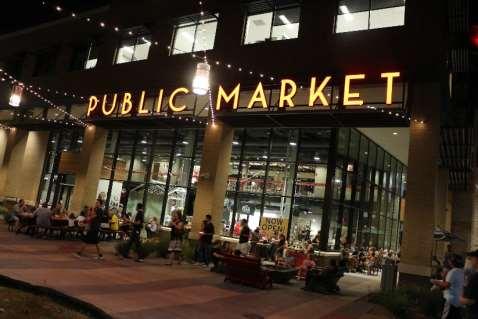

SITE PLAN
Commons


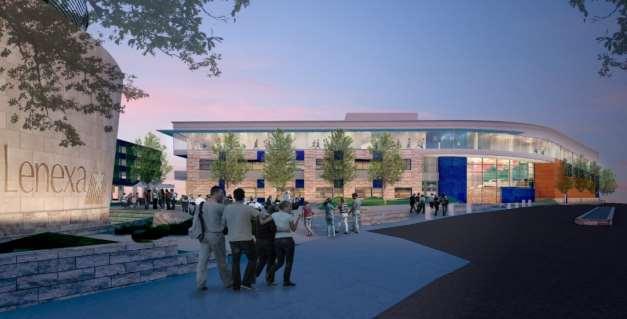

Library
SM Aquatics Center
JOCO
Recreation Center
Project Milestones
• Groundbreaking – June 12th, 2015
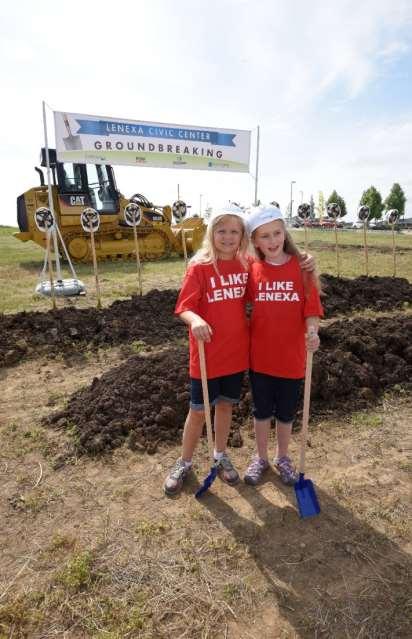
• GMP #1 Issued – July 10th, 2015 – To allow site work to begin (JE Dunn mobilized in August 2015)
• GMP #2 Issued – October 21, 2015 – Remainder of Project Budget
• Topping Out Ceremony – May 31, 2016
• Length of Construction – 22 months
• Substantial Completion For City Hall / Rec Center/ Parking Garage – June 2, 2017
• Substantial Completion For Site Work – July 7th, 2017
• Move In Date – July 31, 2017
Elevated view looking NW toward Mezzanine
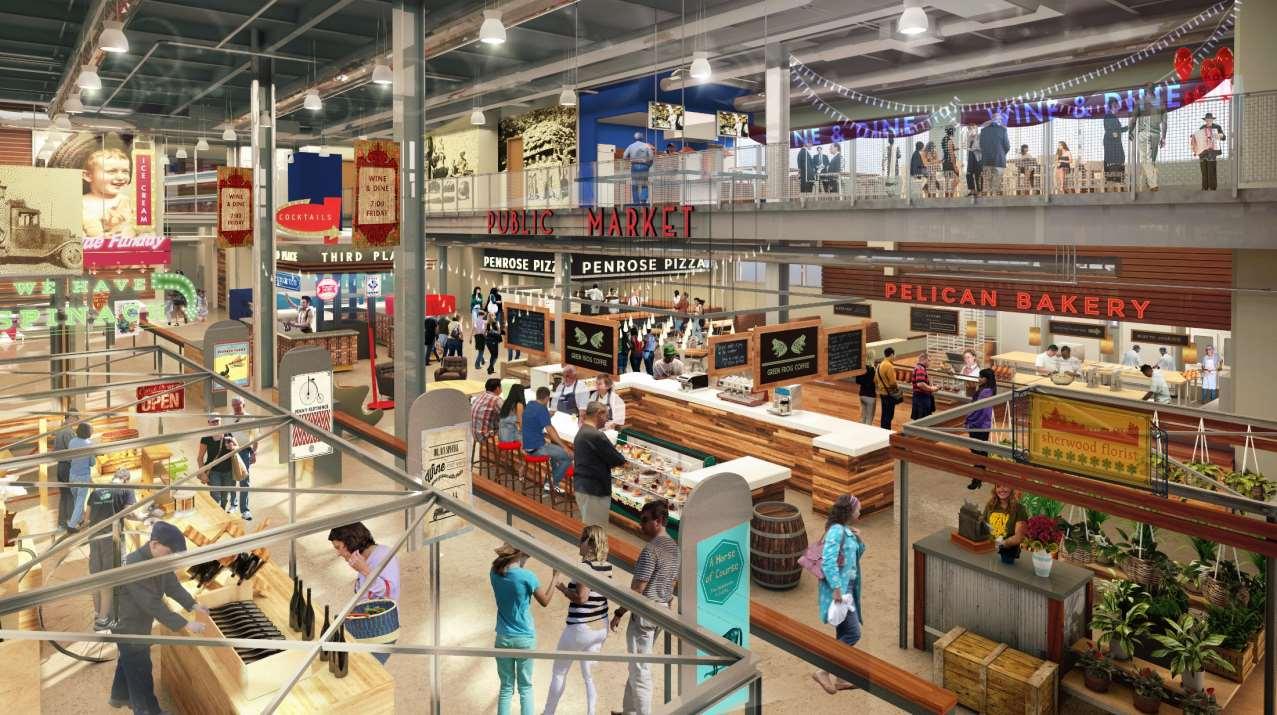

KEY THEMES
Describe the kind of place you want for your community. Invest in the things you value. Independence has great “bones” already in place with history and character.
Create a place where many projects can happen concurrently or in phases. It will not all happen at once.
Be prepared for plans to change. The original Civic Center plan called for 1 million sq. ft. of retail. Retail landscape is different today, so there is a heavier emphasis on office, service, residential and restaurants.
Partner with the private sector. Make strategic public investments to entice private development.
Accept risk and stay committed. During the recession a private development failed, and a high profile 5-story building sat incomplete for two years. Ultimately the City acquired and demolished the property at public expense in order to advance the vision. That’s the level of commitment needed.
14
KEY THEMES, CONT.
Lenexa also toured other communities early in its process and learned that successful developments were anchored by public facilities. The City of Lenexa became a development anchor with city hall and the public market. It showed the development community that the City was serious.
Be patient and stay true to the vision, but be adaptable. Johnson County backed out of library partnership during the recession, but the City redesigned to hold out that they would come back in the future (they did).
A special zoning district was created to de-emphasize the car in favor of very walkable spaces; drive-thrus are prohibited (which excludes certain retail/restaurant).
Design standards were created for an urban standard to counter traditional suburban zoning (height restrictions, setbacks, etc.).
Understand your target audience. Civic Center was planned for active seniors (renters by choice, aging in place) and young families. Design and development decisions were influenced by their needs.
15
CITY HALL
• Designed to be more than an office building.
• Used technology to connect to remote campuses (Fire, PD).
• Space is flexible to accommodate changing needs.
• City Hall is integrated with public spaces, public market, Park University.
• Round table for senior staff meetings facilitates engagement and open dialogue.
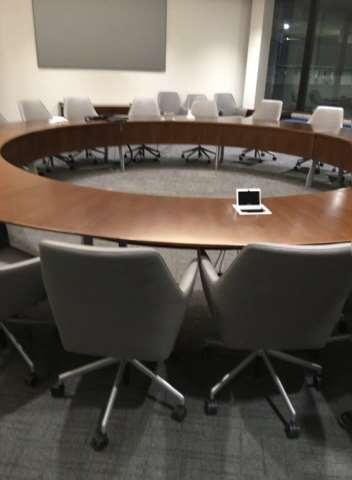

16
Lenexa Public Market is a business incubator adjacent to City Hall. It is equipped with a demonstration kitchen. The City manages tenant leases and works to ensure that vendors to do not duplicate/compete with the farmers market.


17
Lenexa advocated for special legislation to allow consumption of alcohol in designated common areas.
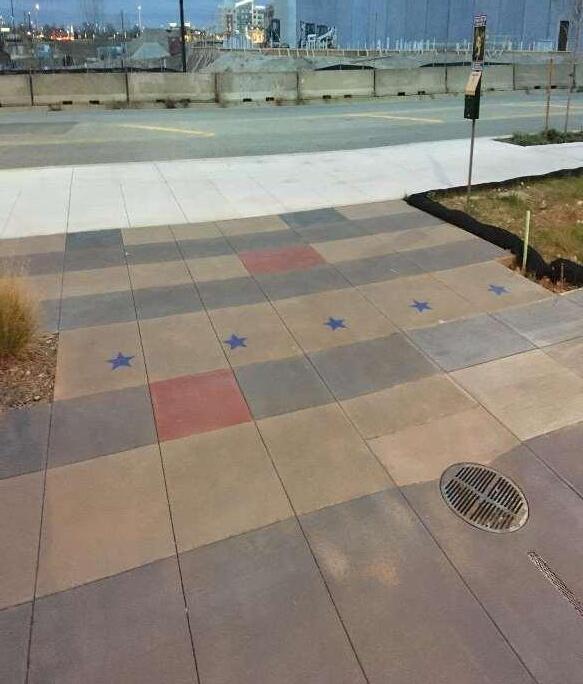

18
Farmers Market awning was designed for dual use of parking garage – vendors back up to stalls.


Banners on parking garage highlight community & project values – nice design element.
Outdoor stage was designed on west wall of City Hall. Originally conceived as a terraced amphitheater, a flat surface was constructed for multiple programming options.

19
Plaza identifies events and concepts of historic significance to Lenexa. QR codes link visitors in to additional information.

USS Enterprise! – The lighting on City Hall is a design feature to create a more welcoming space and break up the building façade.

20
• Rec Center construction was funded by a 3/8-cent 20year sales tax for roads and parks.
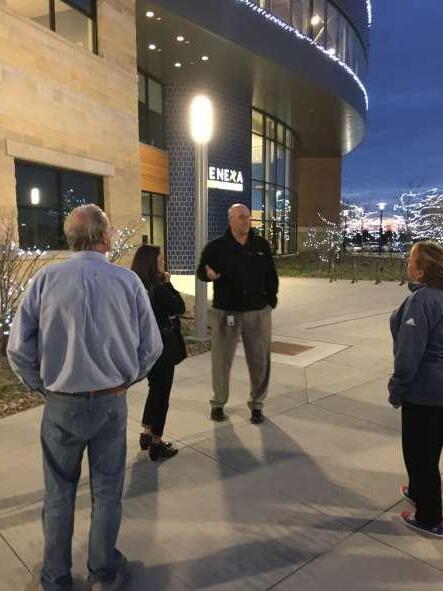
• Building was planned for subsidy in the first few years but will ultimately be self-sustaining with memberships and program revenues.
• The table shown above was conceived and constructed by Lenexa Parks & Recreation staff.
• Common areas are free to public (WiFi, open seating). Services require membership.

21


22
“Gotta have the kids stuff.” –Dr. Alan access for all
• Signage and programming uses the consistent “X” theme – X Pass, X classes, etc.

• Gained staffed efficiencies by housing Parks & Recreation staff in the Rec Center.

23
Rec Center features one of the longest indoor tracks in the area – 6 laps per mile. It has a 5 degree slope to mimic a natural trail.


24
View from the yoga patio over South Lenexa (Olathe)
Many examples throughout the tour of prominent displays of community values, public servants and branding.
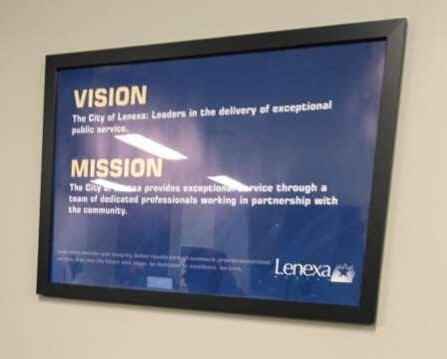

25
DOWNTOWN REDEVEOPMENT Independence Downtown Redevelopment Coordinating Committee December 7, 2017 1
GLADSTONE
MEETING SUMMARY
A meeting of the Downtown Redevelopment Coordinating Committee was held at 4:00 p.m. on Thursday, December 7, 2017, at the City of Gladstone City Hall at 7010 N. Holmes St., Gladstone, MO 64118. Committee members present were Chair Curt Dougherty, Bryan Conley, Tom Garland, Jill Getman, Jennifer Manulelua, Matthew Medley, Linda Ellis Sims, Brian Schultz, Trevor Tilton and Alan Williams. Linda Brosam and Monte Short were absent. Assistant City Manager Lauren Palmer also attended. The meeting adjourned at 5:45 p.m.
2
MEETING HOSTS
Scott Wingerson, City Manager
Bob Bear, Assistant City Manager
Austin Greer, Assistant to the City Manager
Becky Jarrett, Executive Assistant
The hosts conducted a walking tour of the downtown redevelopment area and discussed the sequence of development projects and factors for success.

3
SEQUENCE OF PROJECTS
1. Reconstruction of 70th Street (MARC federal transportation grant) – first attempt at incorporating amenities into a street design. There was skepticism about making that level of investment in an economically stagnant area.
2. Community Center – became the first development anchor (200,000 visitors per year) along 70th St. The facility was a spark but did not generate enough activity to change the market. The City needed a clear vision and new urban design standard (i.e. density, setbacks, art requirement for developments that utilize tax incentives).
3. Linden Square – civic space for concerts and ice skating; adds to ambiance.
4. Polina Office Building.
5. Laughing Place Bakery Building – started as a business incubator and Snow & Co.; original uses didn’t work but new uses are doing well.
6. The Heights Apartment Complex – 225 luxury units.
7.
4
Northland Innovation Center – partnerships with K-12 and higher education.
FACTORS FOR SUCCESS
Set a clear objective: Reinvent ourselves to be sustainable when long-term families move out or die (aging housing stock); preserve a relevant citizenry. Identified a priority development area and patiently land-banked over a period of years.
Success rested on the ability to set and communicate a clear vision.
The Heights was a game changer. $20 million economic impact, but the impact on community pride was intangible. 70% of tenants were first-time (new) residents of Gladstone.
Understood and marketed Gladstone’s competitive advantage: easy access to highways and airport. Planning and public engagement – really listened to what the community wanted. No one commented at the public hearing for The Heights because it delivered on community expectations.
5
COMMUNITY CENTER
• $25 million facility funded through ½ parks sales tax revenue bonds.
• Partnership with NKC School District to convert from a dry to a wet facility.
• Leisure pool and full competition pool – City programs pools when not in use by NKCSD.

• City Arts Commission coordinates rotating display of work from local artists.

6
Banquet facility seats up to 250 and is highly utilized for community/senior meetings and weddings.
Only major capital improvement since opening was AV system overhaul for technology upgrades.

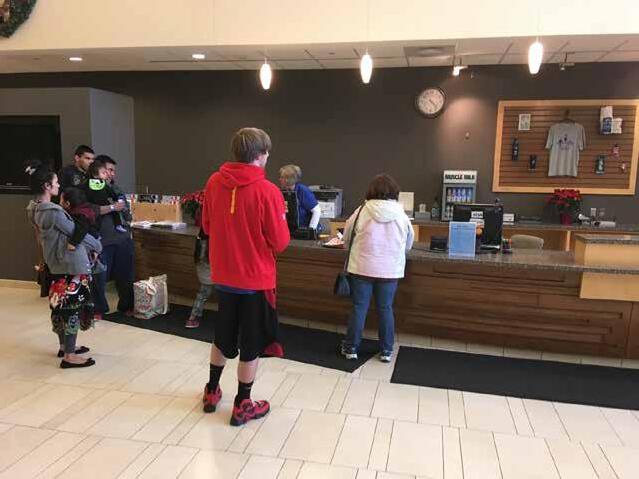
7
LINDEN SQUARE
$750,000 project
First time development work focused inward for resident/community needs rather than market demand.
Performance stage
High density plastic skate rink installed to save on equipment costs (in hindsight, real ice is preferred).
Project had a slow start with attendance at events. Now averages 465 per performance.

8
THE HEIGHTS
225 luxury units and 10,000 sq. ft. of retail space; $26 million investment
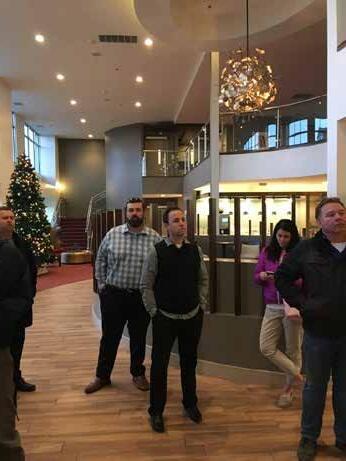
Funded with Ch. 100 bonds; completed analysis with school district to determine number of students and impact of tax abatement.
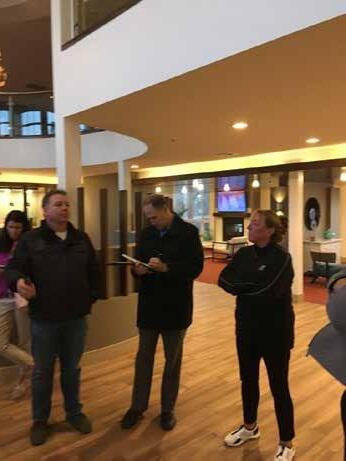
Technology and pet friendly.
Average age of tenant = 34; average income = $64,000.
Rents were highest in the Northland at time of opening. Council directive: “Set quality and set records.” Built maintenance reserves into development agreement to ensure lasting quality.
High density was part of downtown plan – 45 units per acre.
Did not issue development RFP; approached by developer from Indianapolis and negotiated a development agreement based on understanding of the vision.
9
NORTHLAND INNOVATION CENTER
• 90,000 sq. ft. – City is landlord.
• Tenants include North Kansas City School District and Northwest Missouri State University.
• NWMSU’s original plan for ≈2,000 sq. ft. grew to 18,000 sq. ft. for an urban campus to help recruit professors and support distance learning.
• A second new construction phase is planned when enrollment reaches 1500 students.
• Missouri S&T recently leased 3,000 sq. ft. for a similar model.

10
NORTHLAND INNOVATION CENTER


Public art requirement for developers who use tax incentives

11
View of future development sites from NIC (land banked by City of Gladstone)


Mixed retail

Boutique hotel

12
KEY TAKEAWAYS
1. Planning – Results are not due to a single downtown plan but rather an amalgamation of numerous plans over time. All past plans are relevant and build on each other. Solid planning is crucial for recruiting the right development partners who understand and buy into the community vision.
2. Financing – 2005 Gladstone on the Move Community Plan was adopted in response to 09/11/01. The city rightsized and siphoned off excess funds to prepare for an uncertain future. Fortunately negative impacts never materialized, which left $750,000 available to begin land banking. City made extensive use of Certificates of Participation (COPS) and Ch. 100 bonds. Adoption of Parks Sales Tax for construction of Community Center was critical.
3. Partnerships – Major trust with counterparts at school district to negotiate Community Center partnership on risk ($75,000 of investments prior to formal agreement). Foundation was there with relationships that started developing decades earlier.
13
FUTURE OBJECTIVES
Fill vacant retail space in The Heights with upscale restaurant; City Council has patiently held out for three years for the right tenant (announcement soon).
Placed 2nd in a bid for a Fortune 500 company project; consider success since first application of its kind.
100-125 room boutique hotel.
Art incubator and entrepreneurial center. Municipal facilities – didn’t upgrade as part of original development but now acknowledge that City Hall is the worst building downtown.
14
FUTURE DEVELOPMENT PLANS WEST OF N. OAK TRAFFICWAY
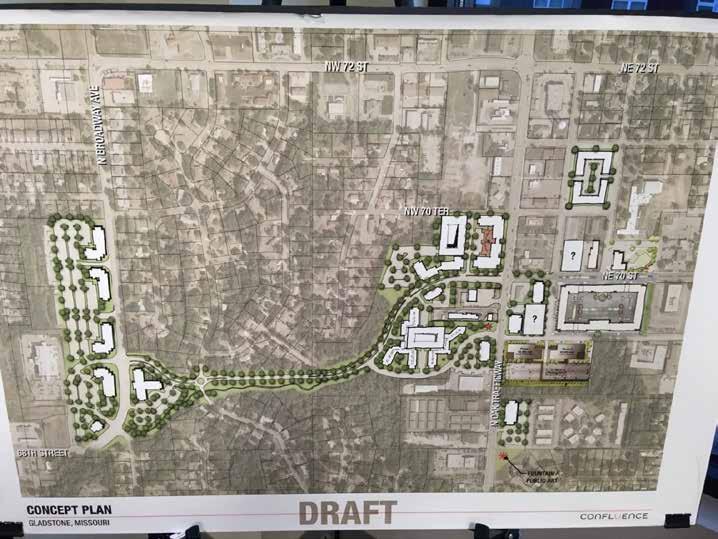
City Hall
The Heights Apartment Complex


15
Independence Downtown Redevelopment Coordinating Committee
December 19, 2017
LEE’S SUMMIT DOWNTOWN REDEVELOPMENT

Meeting Summary
A meeting of the Independence Downtown Redevelopment Coordinating Committee was convened at 4:10 p.m. on Tuesday, December 19, 2017, at the Lee’s Summit City Hall – Strother Conference Room (220 SE Green Street, Lee’s Summit, MO 64063).
Committee members present were Chair Curt Dougherty, Bryan Conley, Tom Garland, Jill Getman, Matthew Medley, Brian Schultz, Monte Short, Trevor Tilton and Alan Williams. Linda Brosam, Linda Ellis Sims and Jennifer Manulelua were absent. Assistant City Manager Lauren Palmer and City Manager Zach Walker also attended. Bob McKay, Community Development Director, and Steve Arbo, City Manager, gave an overview of development efforts (slides attached with meeting notes in red italics). The meeting concluded at 5:45 p.m.

DT MASTER PLAN
• Community Visioning Study – 2002
Key theme: what do we like that we want to protect?
Cultural art is our Harry Truman.
• EDAW - Denver Consultant Hired – 2003

• Kick off workshop – Feb 2003
• Multiple stakeholder workshops Draft Preferred Plan
Community buy-in and participation throughout process was critical
DT MASTER PLAN
• Preferred Plan - Adopted Feb 2004
– Implementation Strategies Identified and assigned to:
• DTLSMS
• Chamber of Commerce
• Historic Preservation Commission

• City of Lee’s Summit
• LSEDC
• Monthly meetings followed
2004 PLAN INCLUDED TWO GEOGRAPHICAL AREAS:
– Old Lee’s Summit Area – Chipman Road on the north, M-291 on the east, 50 Highway on the south and west. (1,775 Ac.)
– Downtown Core – Maple and First Streets on the north, Grand Street on the east, 5th and 6th Streets on the south and Jefferson and Market Streets on the west. (147 Ac.)
Can’t just address the core; need to look at broader area (similar to Independence approach)

Old Lee’s Summit/DT Core


PREFERRED FRAMEWORK PLAN
OLD LEE’S SUMMIT
– Market Absorption through 2020:
• 30.000-40,000 sq. ft. retail

• 30,000-40,000 sq. ft. office
• 150-300 dwelling units
• 50-80 hotel rooms
– Trench UPRR – Create north/south trail along east side of RR tracks
•
PREFERRED PLAN CONT.
– Increase rental and for sale medium to high density housing stock

Downtown is not sustainable yet; need more density housing; took some unsuccessful risks to increase housing (i.e. dividing older lots)
– Create market driven development along traffic corridor
– Provide better wayfinding
OLD LEE’S SUMMIT CONT.
• Sign regional gateway from east at 291 both 2nd and 3rd Streets
• US 50 auto dealerships would become market-driven, gateway mixed-use sites
• Create new road from Main/O’Brien Streets north along RR to Donovan Rd. for infill residential

OLD LEE’S SUMMIT CONT.
• Maintain key corridors as residential in character
Protecting well-maintained residential areas to signal a transition into the downtown core.
• Establish key historic districts (15) identified in the 2002 Cultural Resources Survey

Lack of community desire to implement local historic districts; no one has taken advantage of federal/state historic tax credits.
• Maintain/improve parks as gateway elements
Focusing infrastructure improvements on major corridors; parks department partnered to rebuild downtown parks.
• Create new green space with new residential dev.
Preferred Plan-DT Core
• Market Absorption through 2020
–
70,000-110,000 sq. ft. retail
–
70,000 -110,000 sq. ft. office
–
300-450 dwelling units
– 10-15 hotel rooms
– Create additional public parking
– Remove lumber yard activities
Tried several unsuccessful attempts to relocate, but people seem to like the “grit.” Don’t over sanitize.

DT CORE CONT.
– Create widened sidewalks on key retail streets
Merchants opposed wider sidewalks for outdoor dining because they didn’t want to lose parking (may have been a mistake)
– Create land-use driven development as opposed to market driven – Provide better wayfinding very popular
– Locate permanent Farmers Market
Downtown CID will match cost 50/50

DT CORE CONT.
• Plan several small gathering places
• Locate a senior center within the DT Core

• Plan year-round entertainment center at the grainery complete with existing silos • Vary the streets to be used for festivals on event size
• Control transitional areas with zoning changes

PROGRESS MADE SINCE 2004
City Hall Relocated to 3rd and Green –
Keeping Significant Presence In DT
Led with improved public spaces; eminent domain was used for City Hall site; didn’t want to lose employees from downtown. Built with a no-tax increase bond issue. Infrastructure and civic spaces were easier to tackle than density housing.
• Parking Garage Constructed with City Hall
Significantly Increasing Parking Numbers in DT
Adopted a pooled parking ordinance to allow new businesses to share public parking; a second garage is planned with ½-cent sales tax proceeds.

•
• DT Major Infrastructure Improvements Including:
Street Replacement
Storm Sewer Replacement
New Curbs, Sidewalks, Street Trees, Lighting – Streetscape Enhancements
Street level trees, sidewalk bump outs; $30-40 million of new public infrastructure in just a few years
Initially received very high bids; interviews with contractors revealed that working near a major AT&T fiber optic cable was inflating prices; city had to design a work around and hold contractors harmless for fiber line relocation; creative approach to control costs. The new infrastructure made a world of difference. Much simpler now to recruit new vendors and festivals.
– Signage/Wayfinding Improvements Scheduled

PROGRESS CONT.
–
–
–





Fire Headquarters Building Exterior Refaced to Compliment the DT Architecture
Hartley Block Renovation
Vogue Condominiums Constructed
Darren Building Added at Corner of 3rd and Douglas

•
•
•
•
PROGRESS CONT.
– TNZ – Transitional Neighborhood Zone
Created – NFO – Neighborhood Fringe Office Zone
Created – NSO – Neighborhood Stabilization Overlay District Established
Historic DT National Register Designation

PROGRESS CONT. • UDO
Amendments
•
• Permanent Public Art Erected – Children of the Heart
• Gamber Senior Center constructed in Old Lee’s Summit vs. DT
• FACE Program initiated to entice store front upgrades in keeping with the historic character of DT
• Depot upgrade – Tuckpointed and new roof

PROGRESS CONT.
• Restroom Facilities added at Amtrak Passenger Loading Area • Festival Streets established in DT with the new infrastructure
• DT Design Standards being considered

PROGRESS CONT.



Before After



Before After


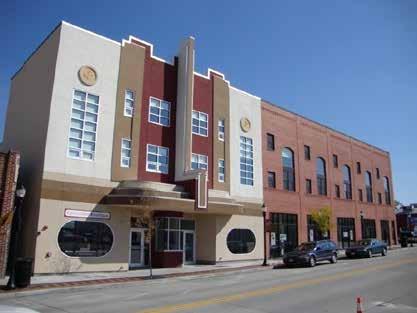




Before After





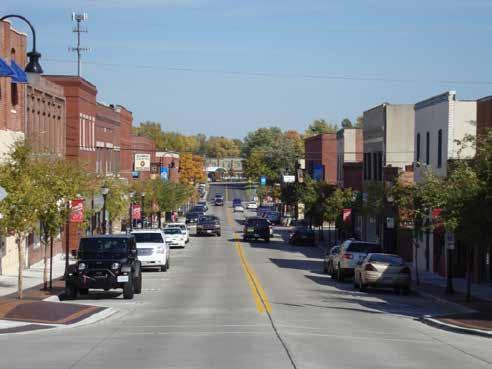
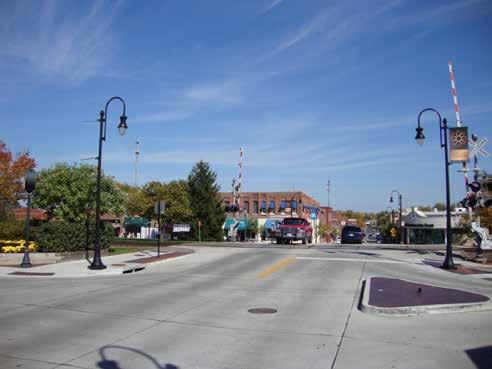
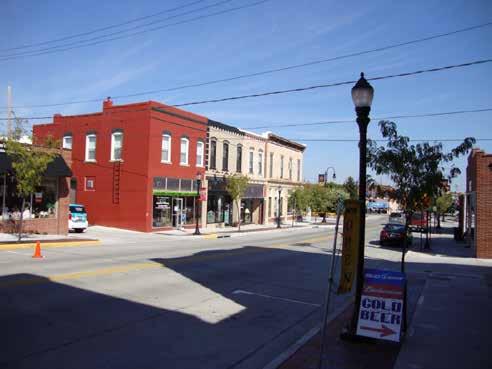


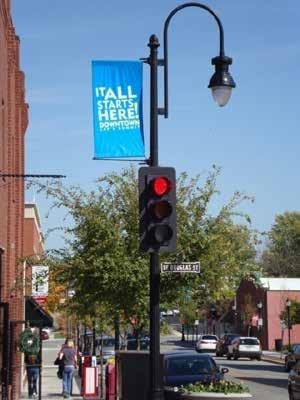









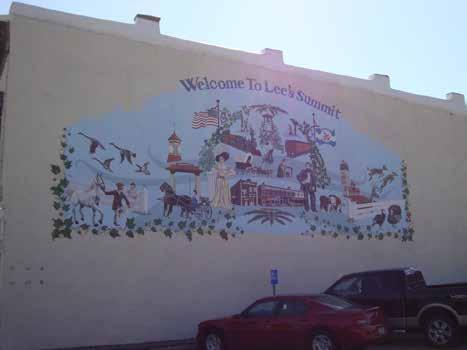




DT MASTER PLAN
• AMENDED 2008 – Recommended Public Structured Parking Locations

Ø 2006 Parking Study Initiated
Ø 2008 Resolution Adopted on Potential Parking Structures
Ø Sites Identified
Downtown Parking Recommendations

1/4 mile walk: 5 min.
1/4 mile walk: 5 min.
1/8 mile walk: 3 min.
Proposed Structured Parking Locations:
New Pkg Spaces:

• Phase I: public/private parking structure on SE corner of 4th / Main
• Phase II: public/private partnership parking structure on redeveloped Post Office Site –west side of DT Core
• Phase III: Arnold Hall Siteshould be intensified and include structured parking
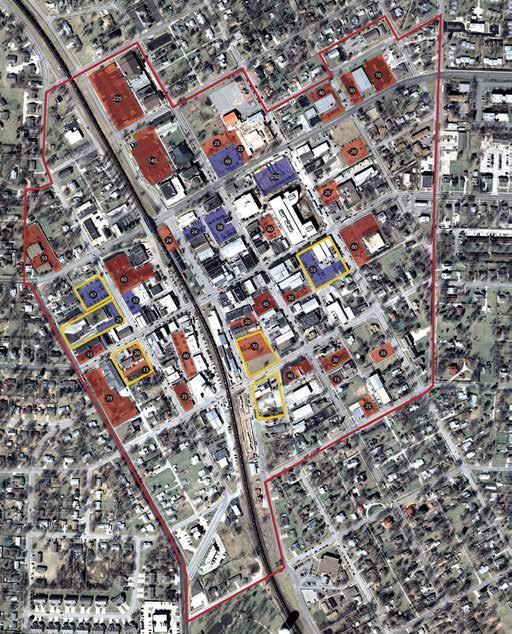
• 195 east of tracks
• 332 west of tracks
• 154-235 depending on development
Sites Evaluated: SE 4th & Main Street Site



Parking:
New Retail: 11,200 sq ft
Other: 11,200 sq ft
195 structured 174 net new 45 needed for new retail
195 Spaces
Downtown Parking Recommendations



1/4 mile walk: 5 min. 1/4 mile walk: 5 min. 1/8 mile walk: 3 min. SE Corner 4th and Main
Sites Evaluated: Post Office and City owned parcel Site



Parking: 332 Spaces
297 structured
surface
existing
net new 76 needed for new retail
New Retail: 19,000 sq ft
Other: 48,900 sq ft
35
92
240
Site Evaluated: Arnold Hall Option 1



Parking: 154 Spaces 144 structured 10 surface 53 existing 101 net new spaces 29 needed for new retail New Retail: 7,200 sq ft


June 19, 2006
Downtown Design Guidelines
6:00 p.m. Historic Preservation Commission and the Downtown Design Committee in a Public Information Meeting
Downtown Design Guidelines
November 13, 2007
6:00 p.m.

DTLSMS & Historic Preservation Commission






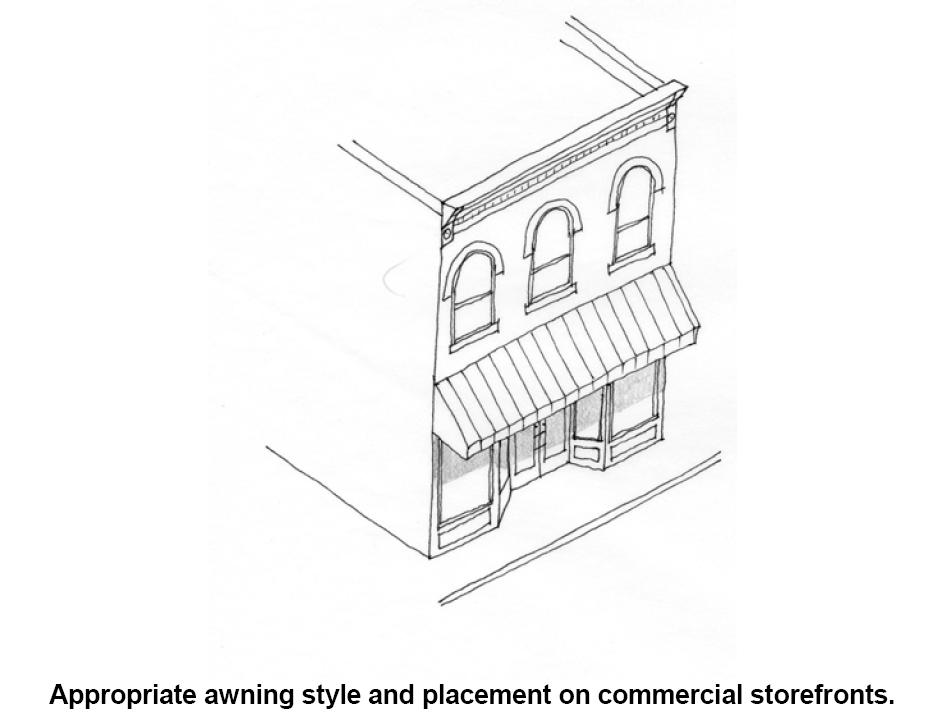








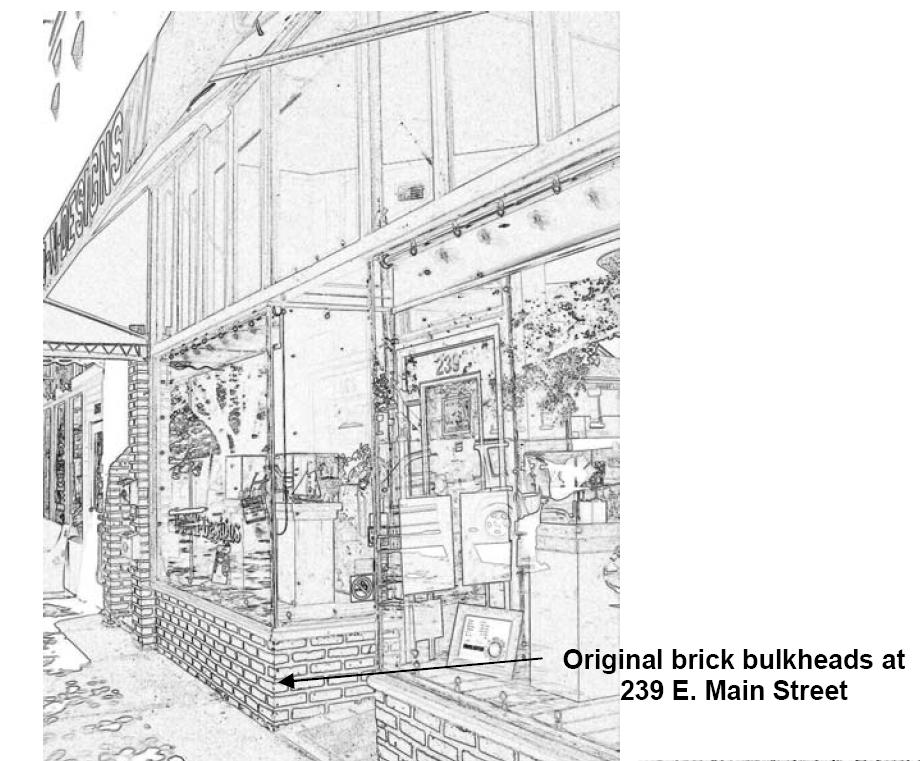
2017 IN PROCESS

• Committee established to review current DT Design Standards • Requests to tighten conditions • Draft amendment complete
• On to CEDC PC
CC
•
Other Thoughts
“We’re happy, but we did the easy stuff first.” Residential density is an ongoing challenge. No desire to use incentives.
• Following the comprehensive plan and other planning efforts was key.
• Sales tax exploded, but the goal was creating a great place and sense of pride. Sustainability for struggling neighborhoods, not economic development, is the objective. Night time activity is driving up property costs, which has consequences. Need to be more than a great place where people enjoy themselves. Need more diversity of uses.
• Unified branding campaign with community partners. Buy media in bulk and resell to partners who align with the message and use trademarked branding.
• A small business person was the best voice of support we had: “It will hurt a little, but it will be worthwhile.”






 Curt Dougherty, City Councilmember
Curt Dougherty, City Councilmember
























































 Lenexa Rec Center
Public Market/ Park Univ./ City Hall
JOCO Library
Parking Garage/ Farmer’s Market
SM Aquatics Center
Lenexa Rec Center
Public Market/ Park Univ./ City Hall
JOCO Library
Parking Garage/ Farmer’s Market
SM Aquatics Center









































































































